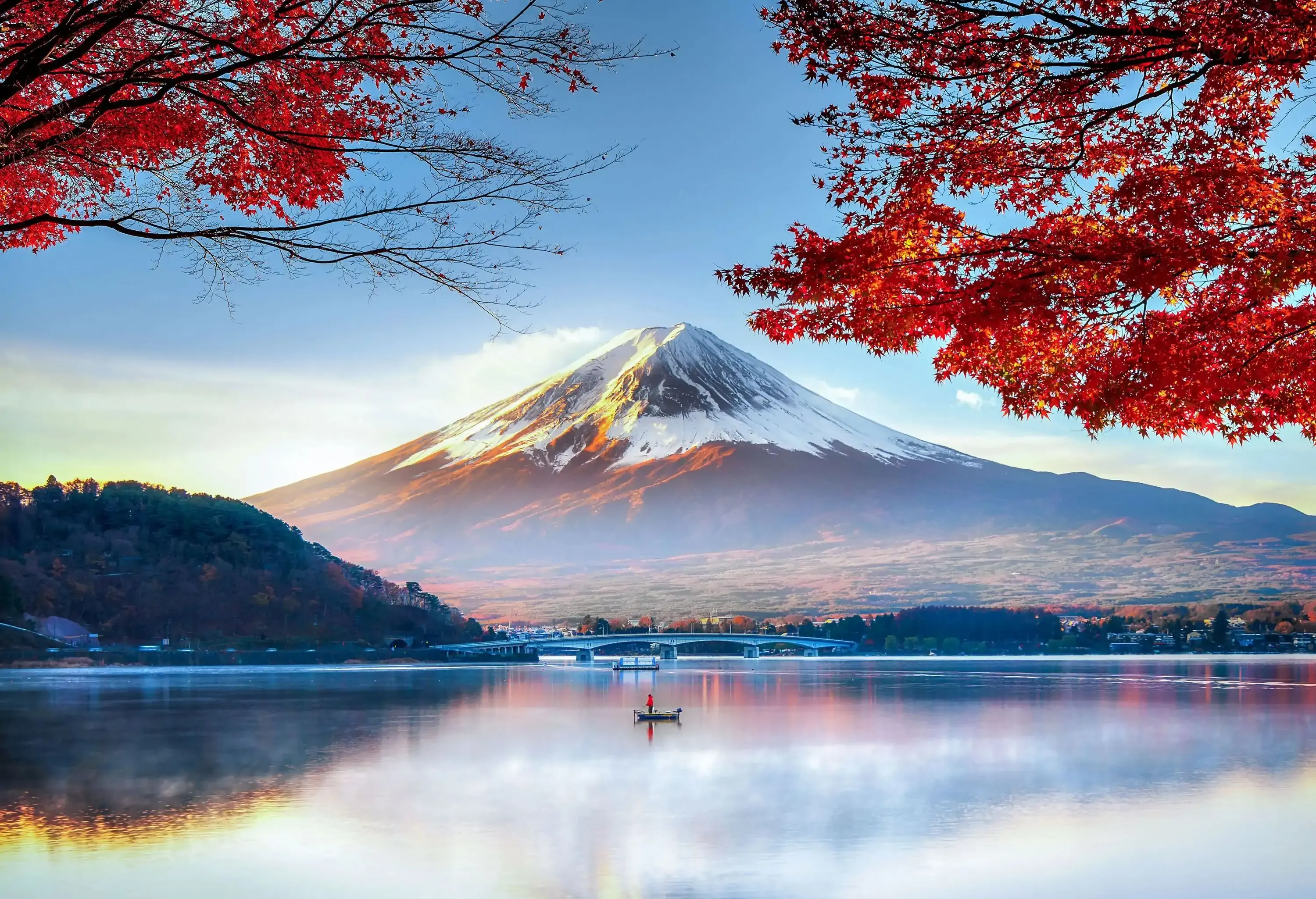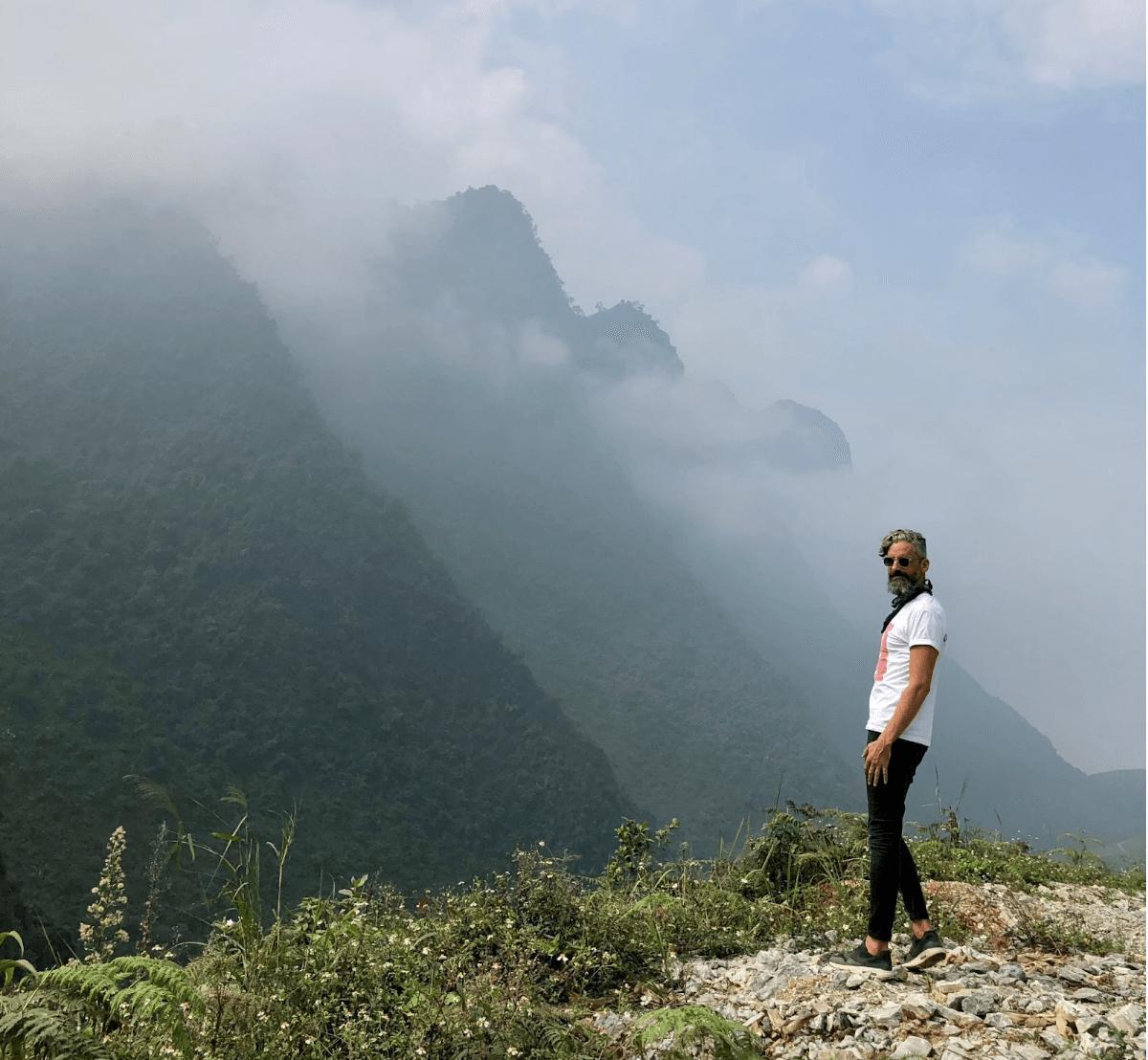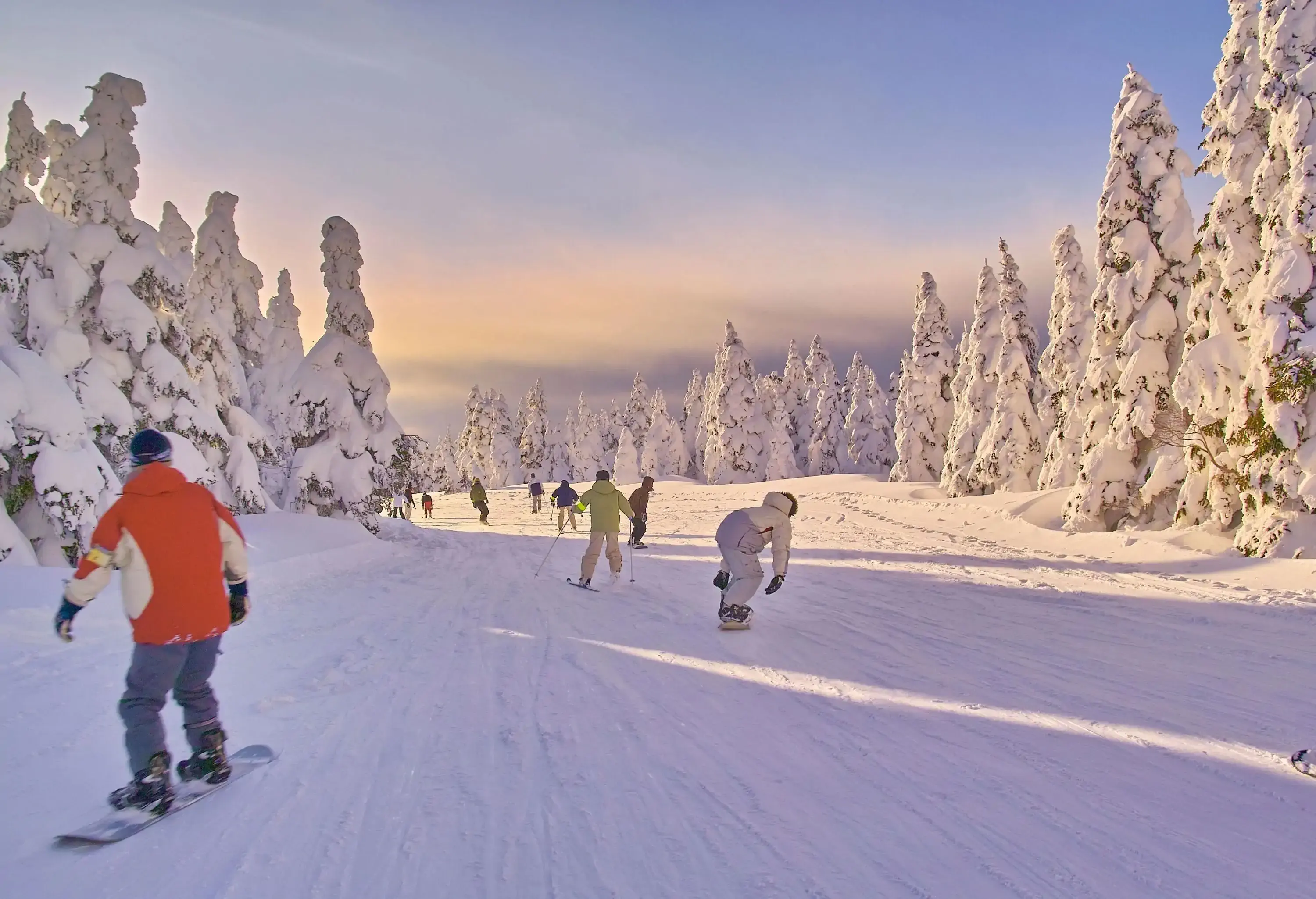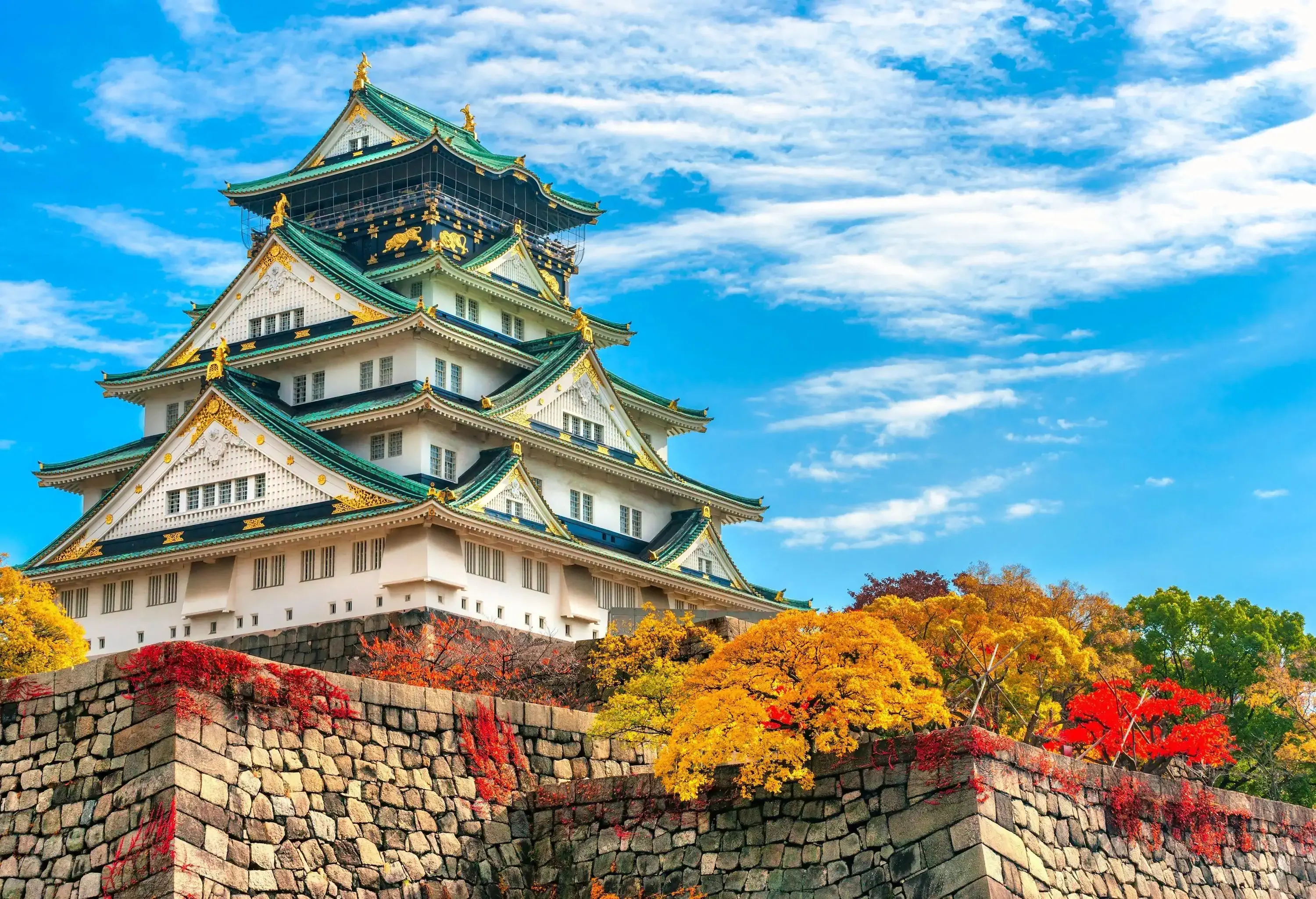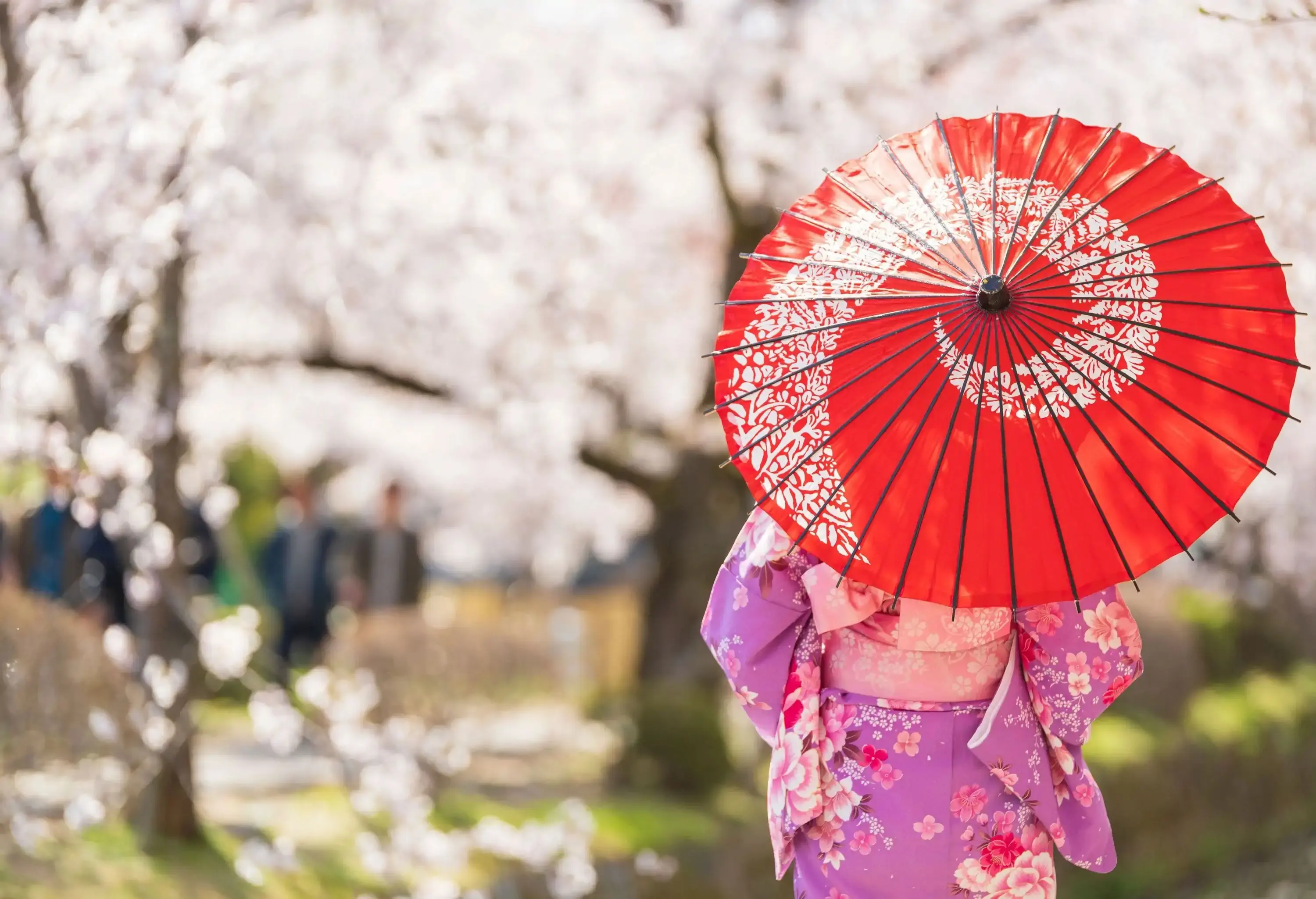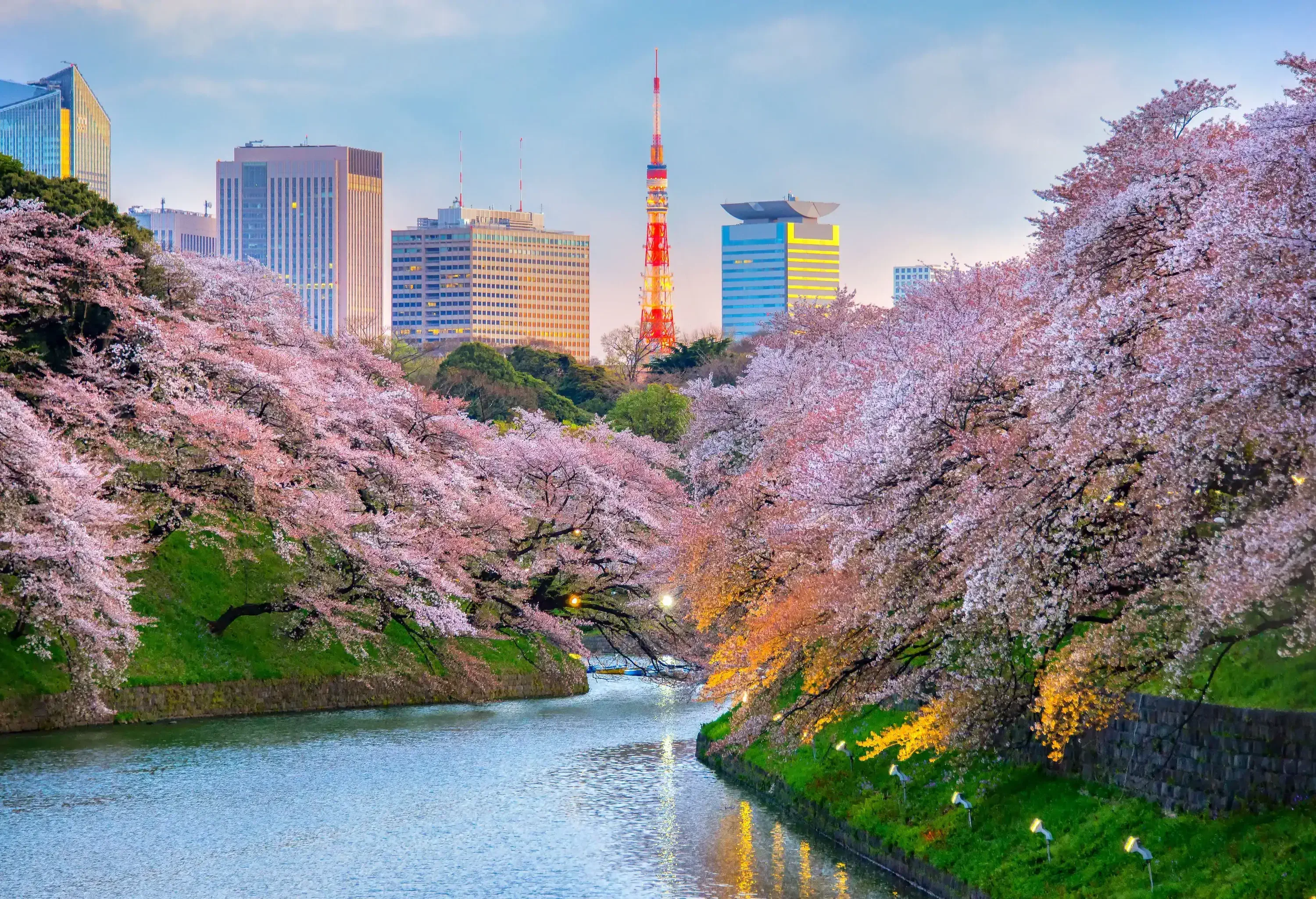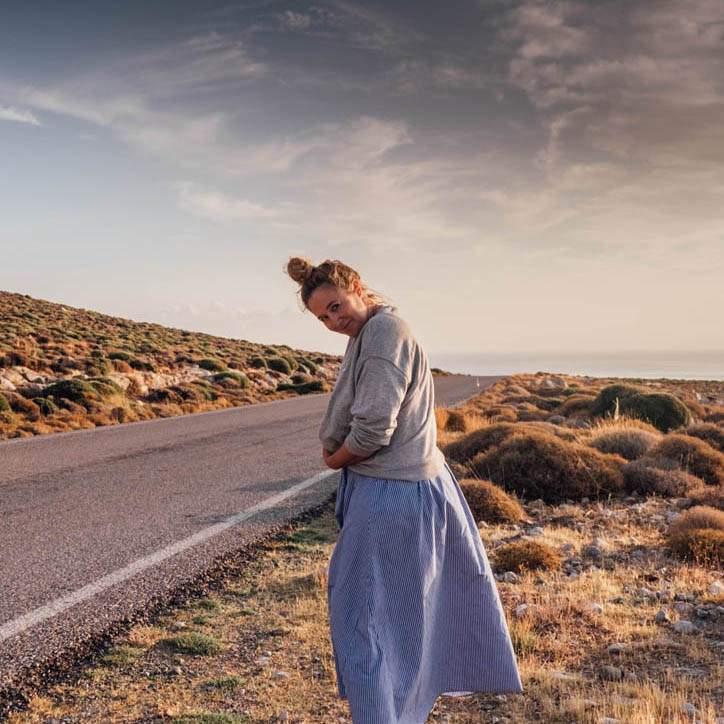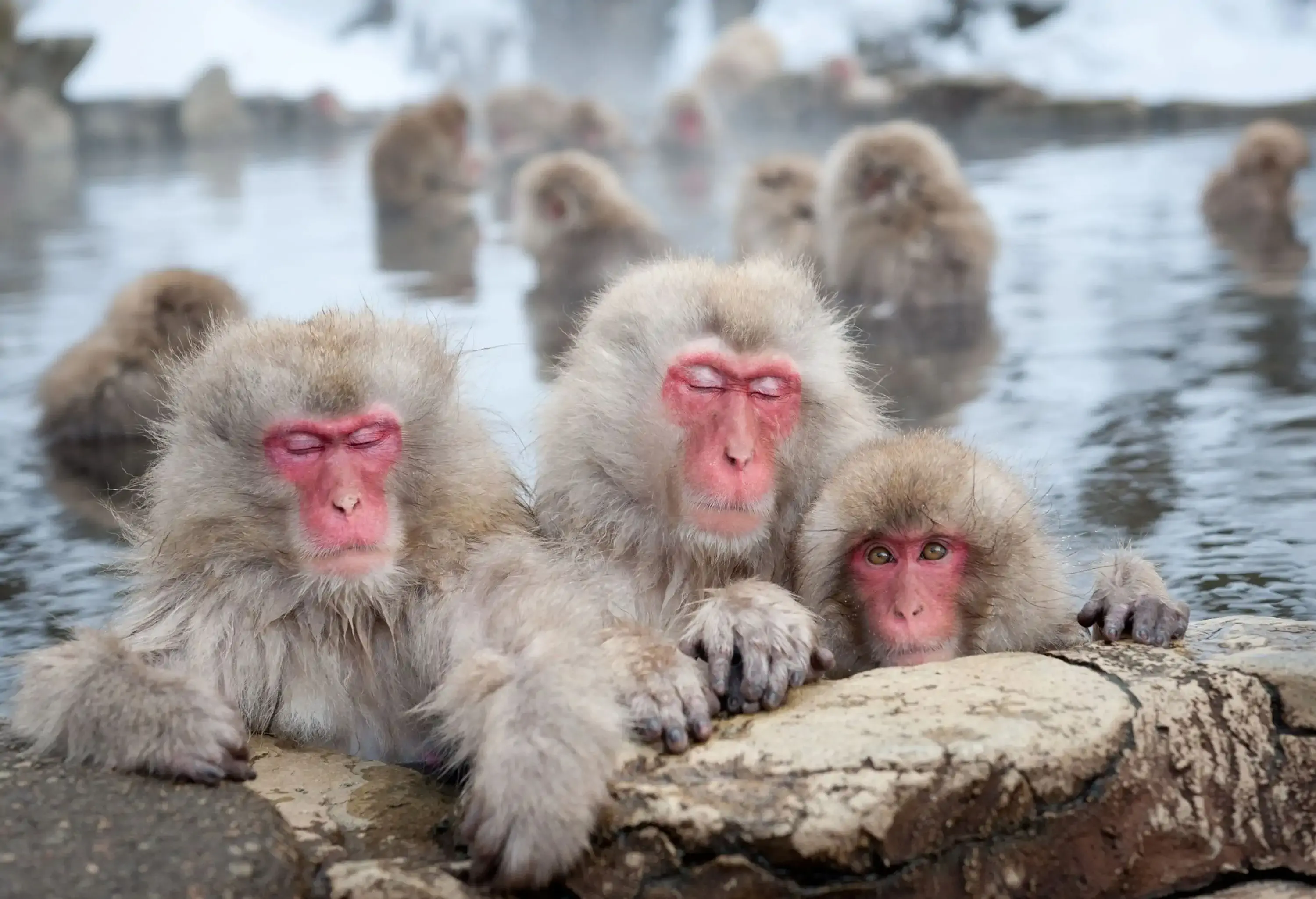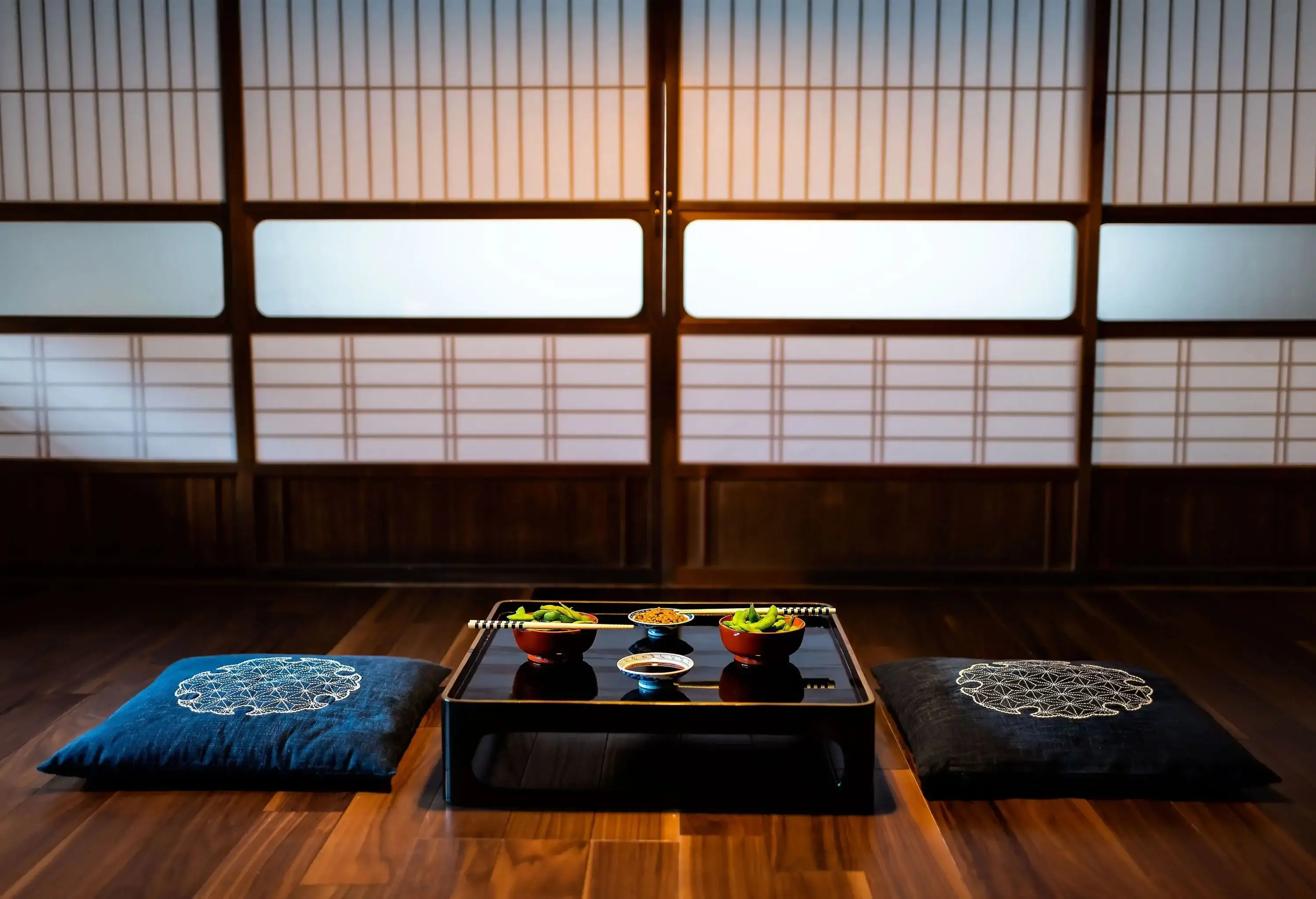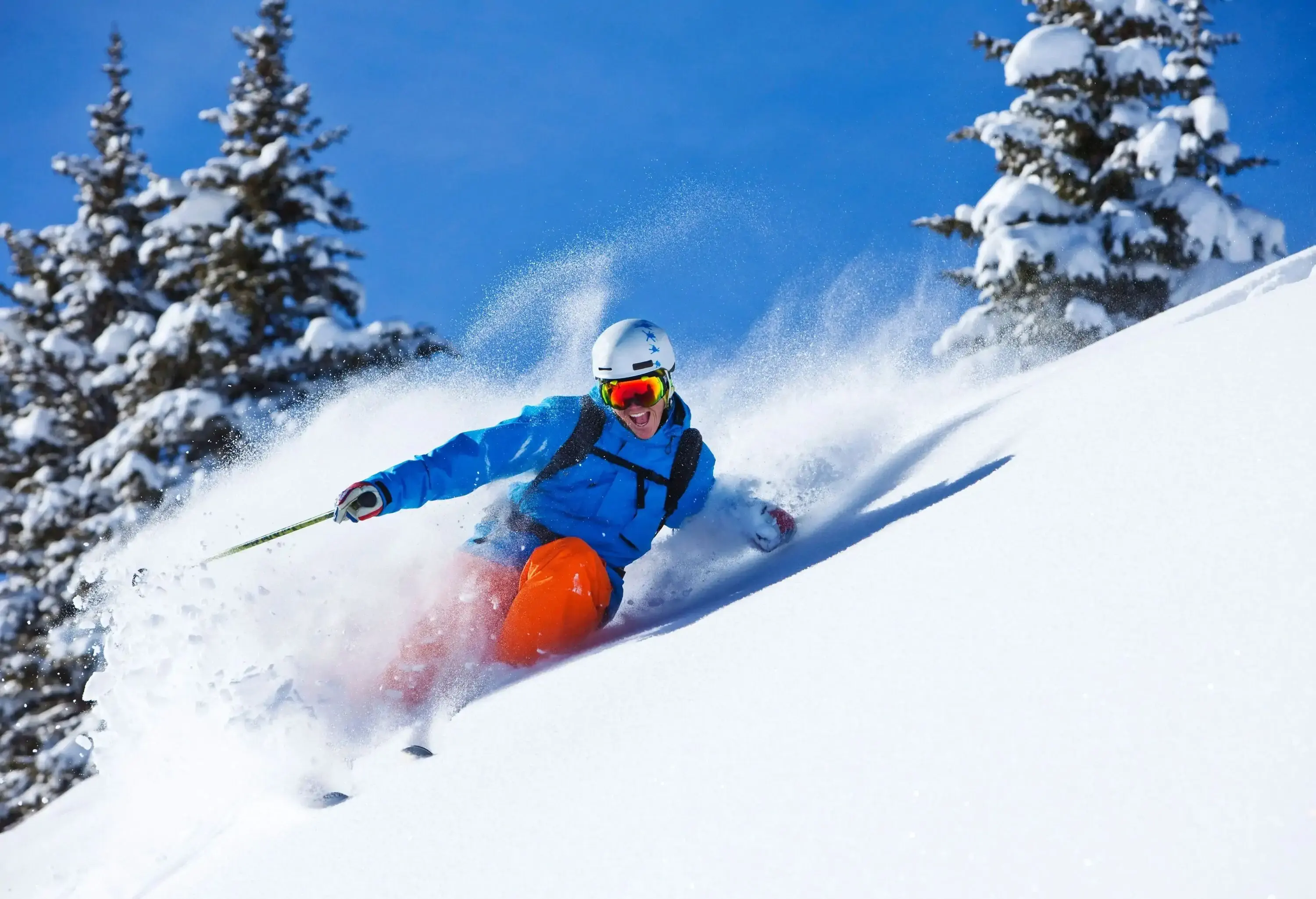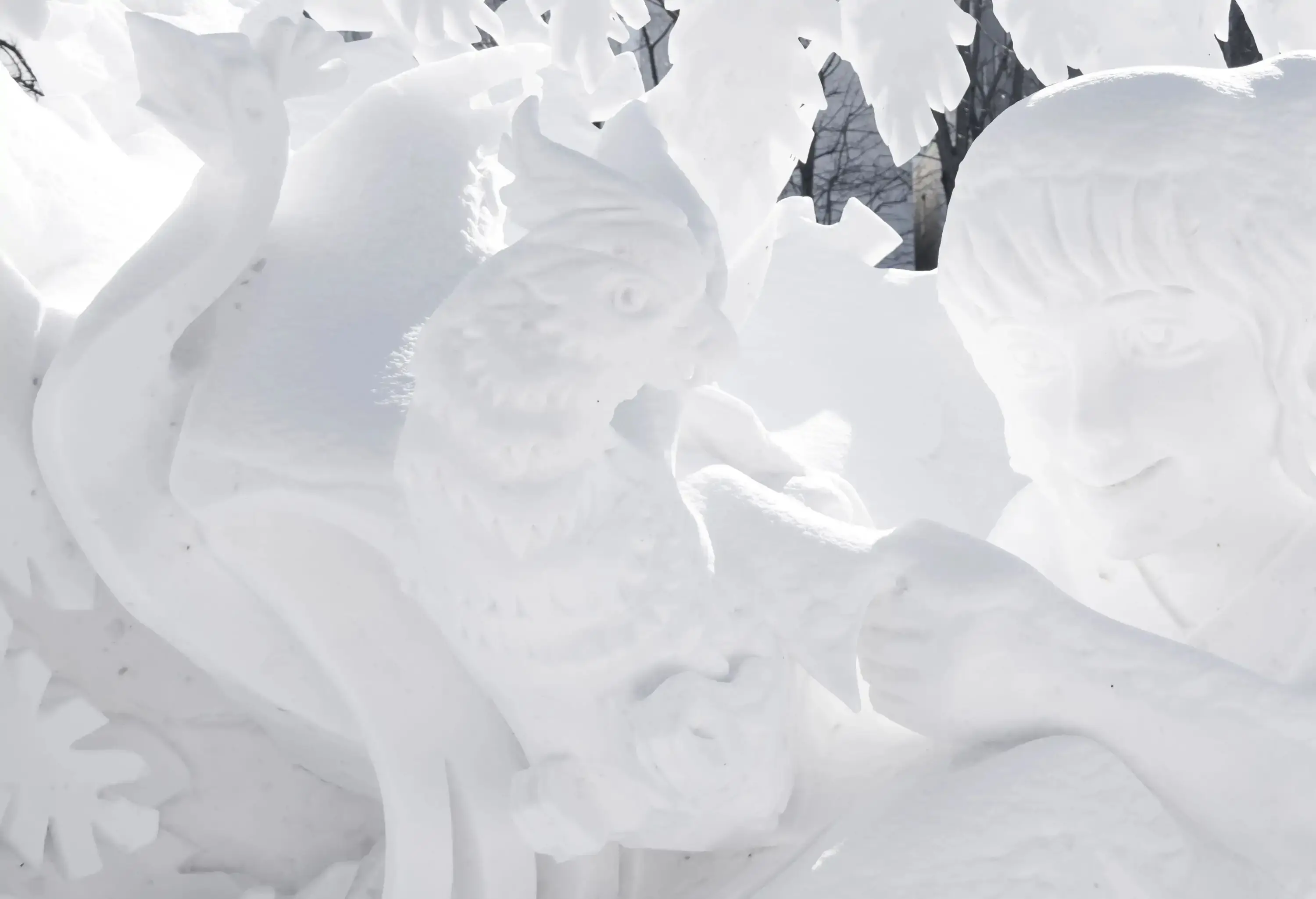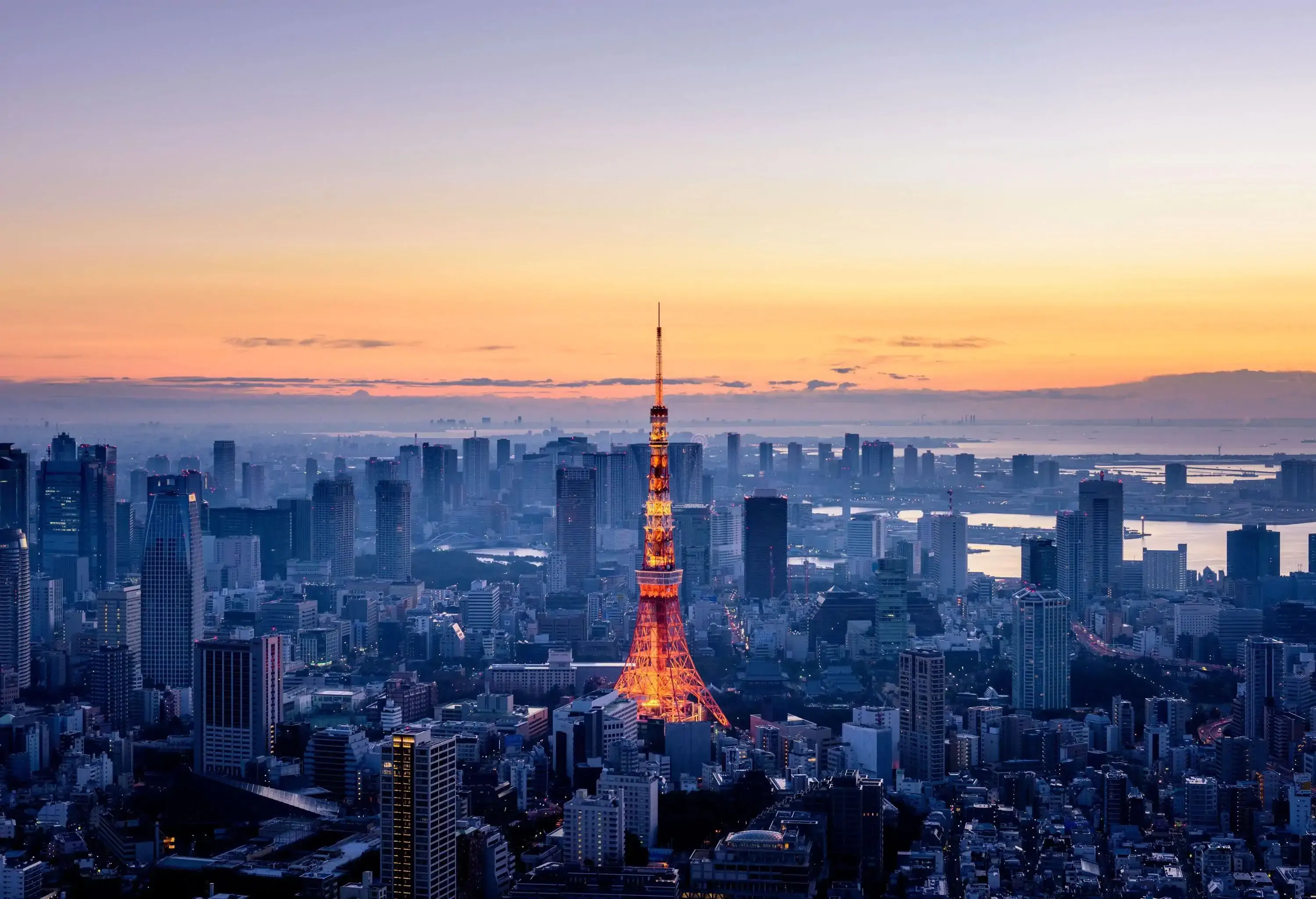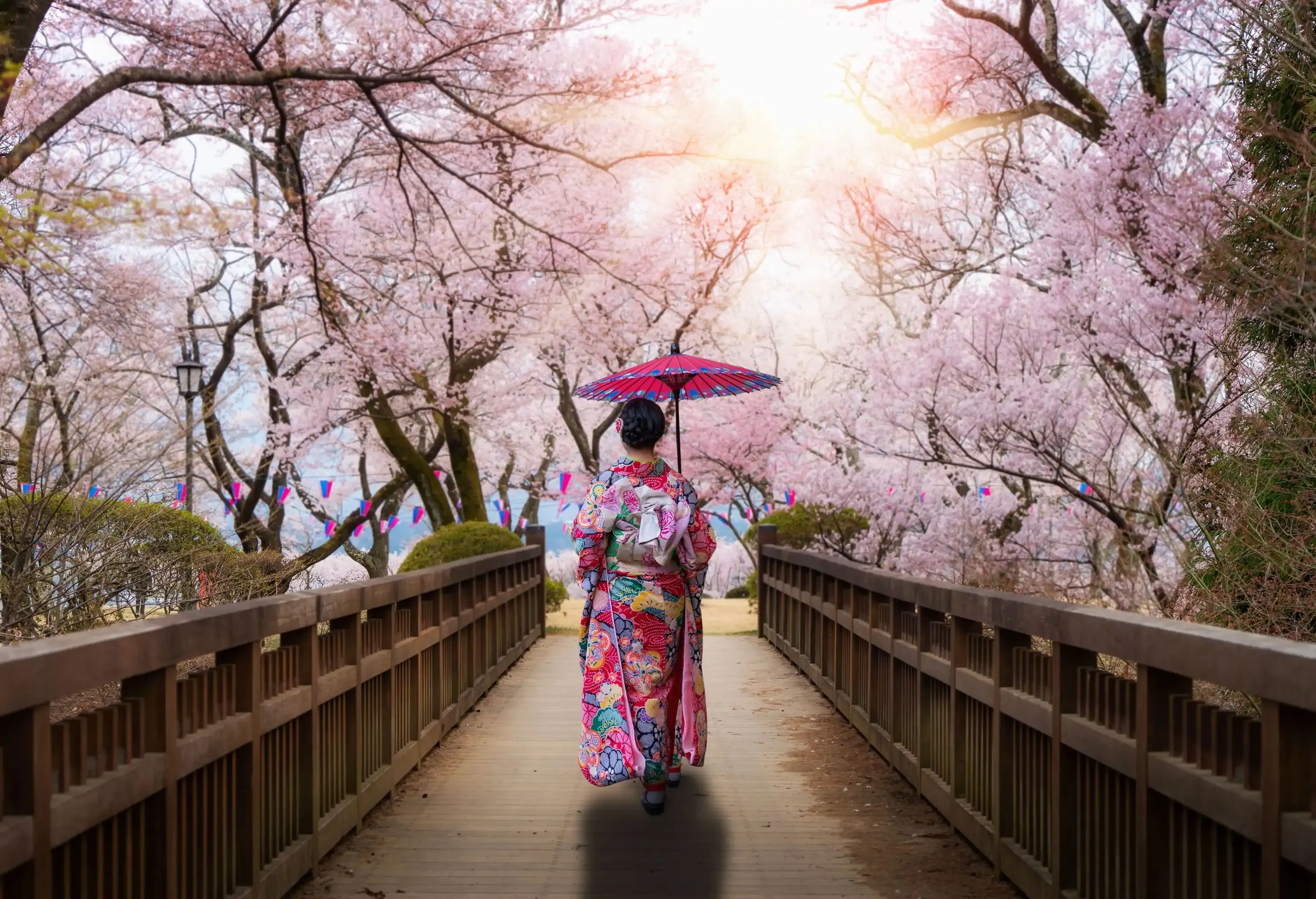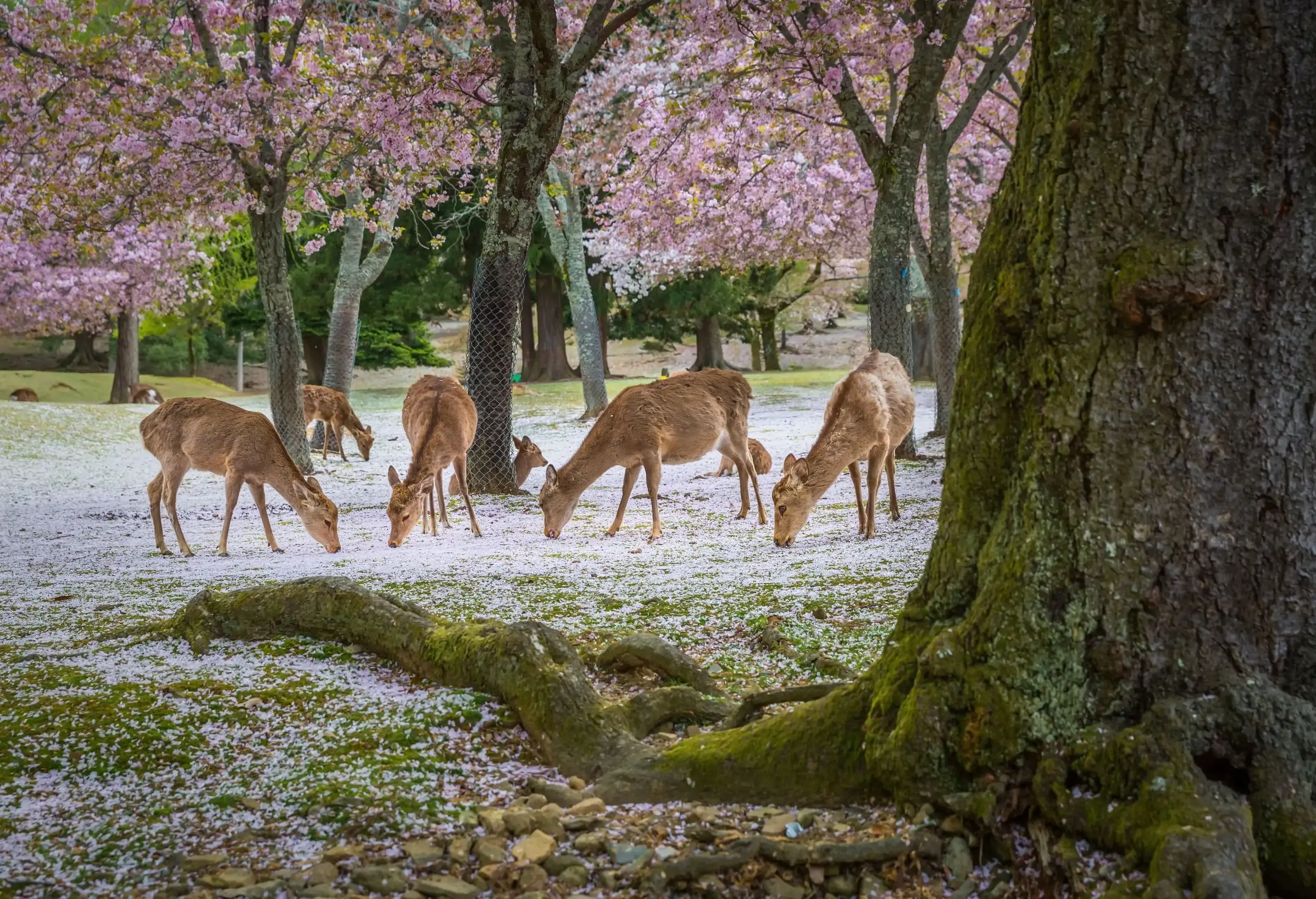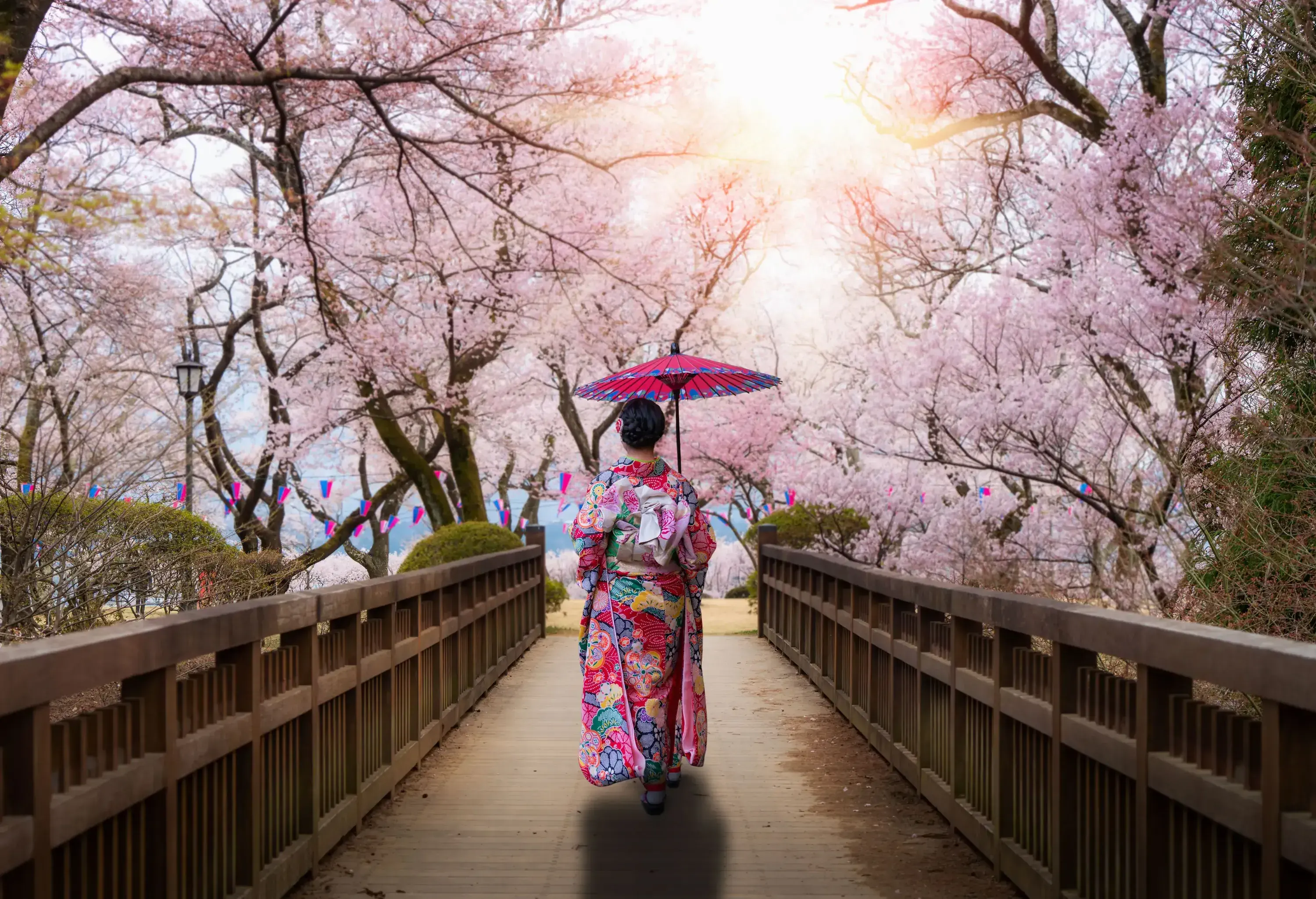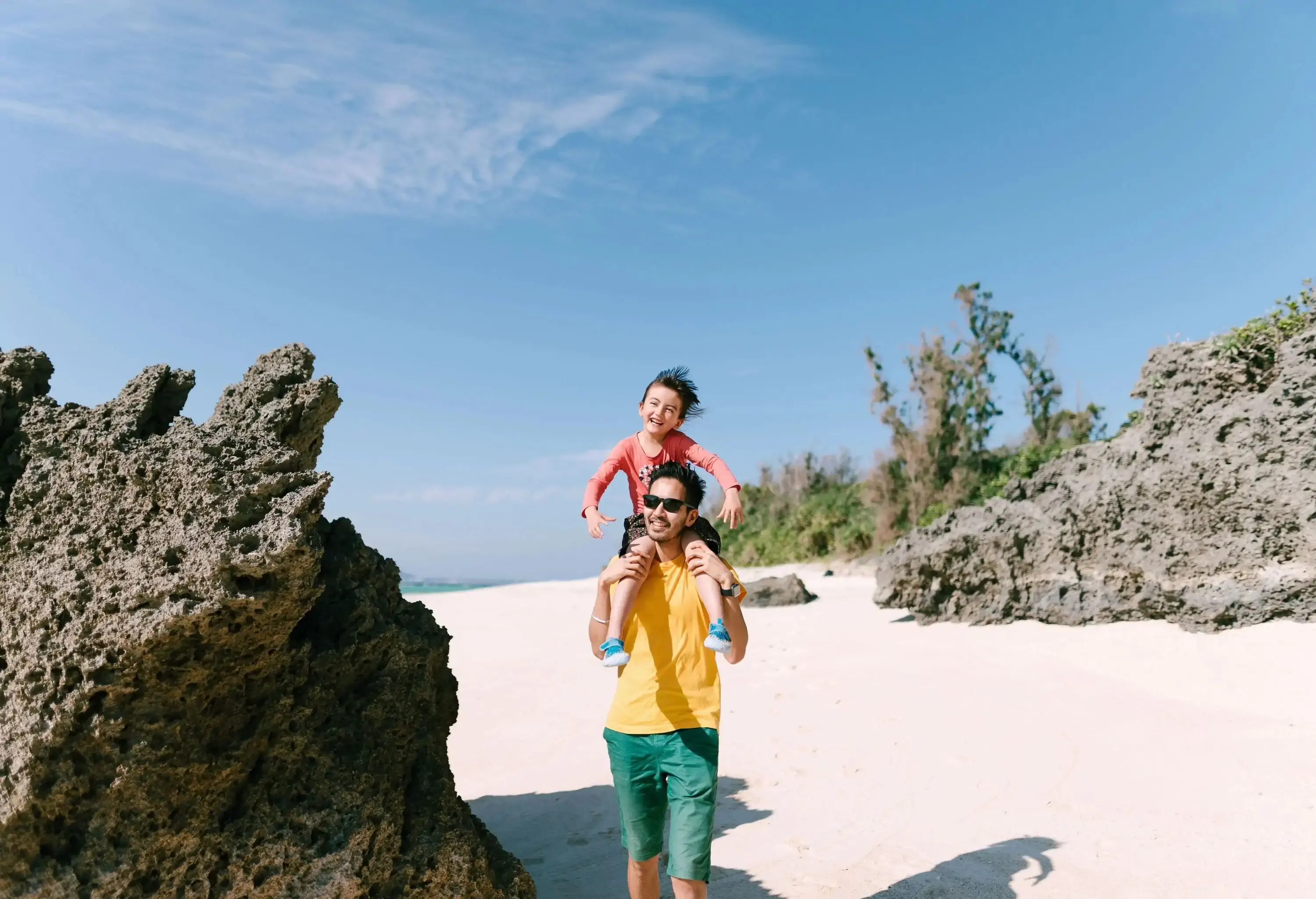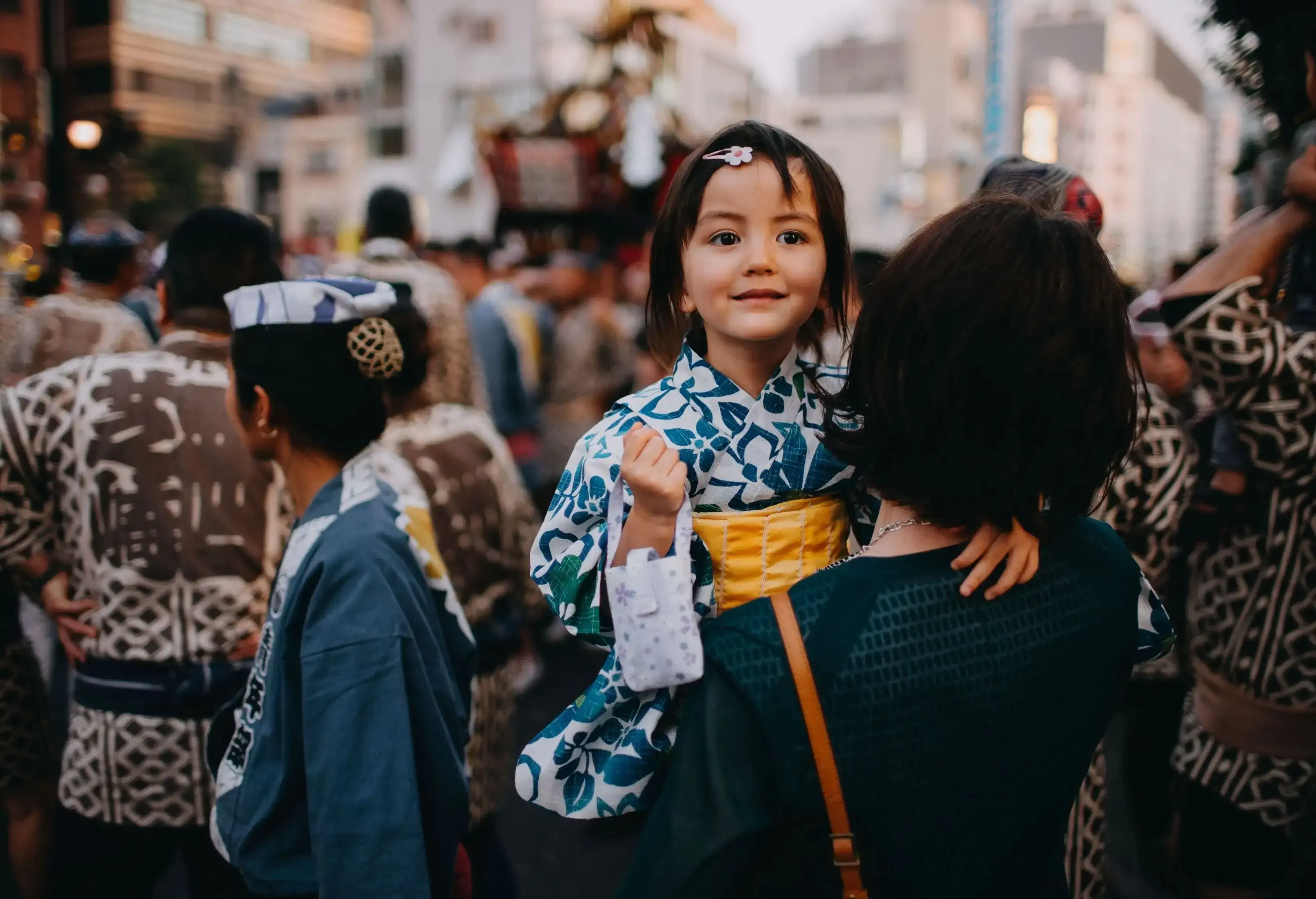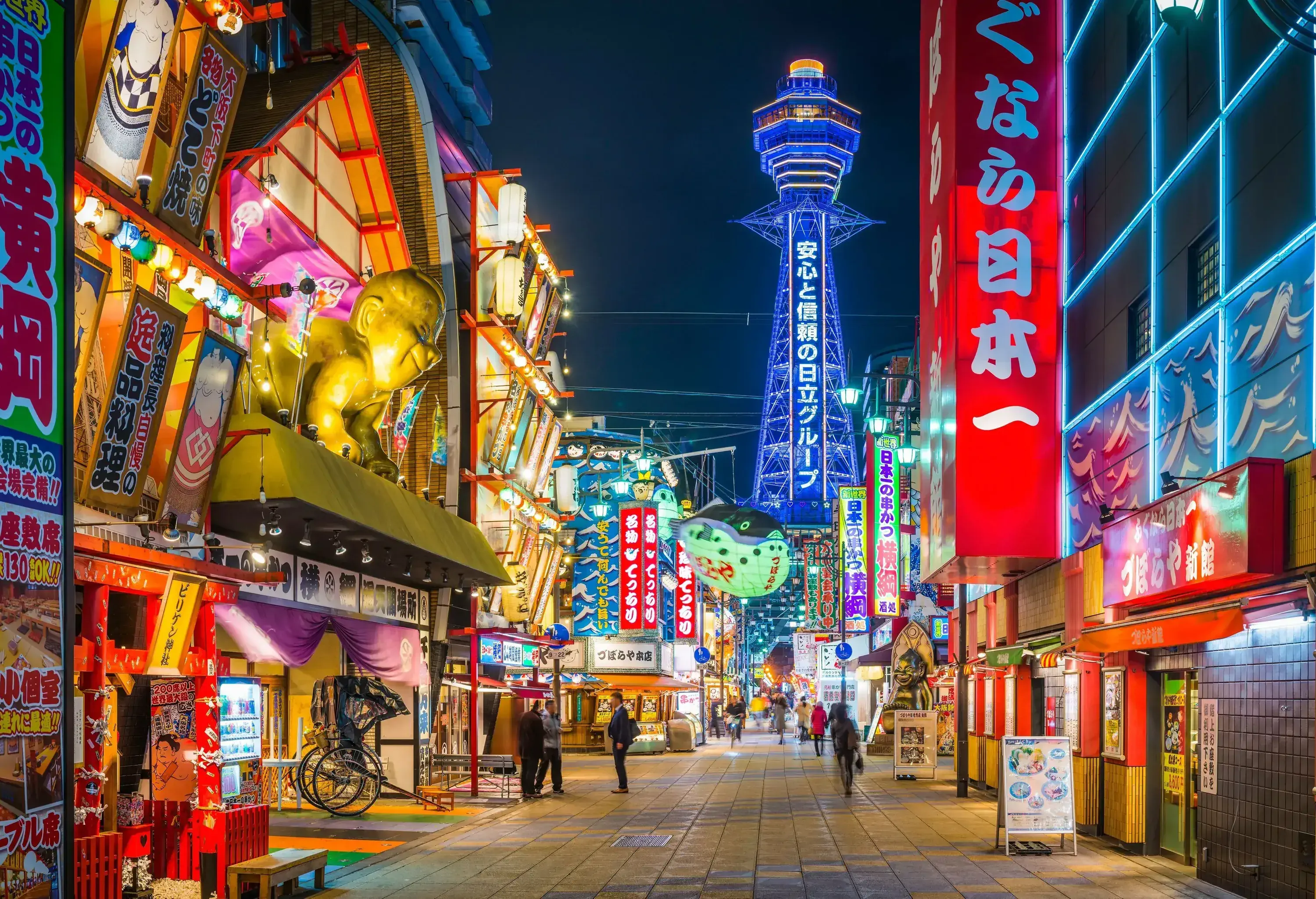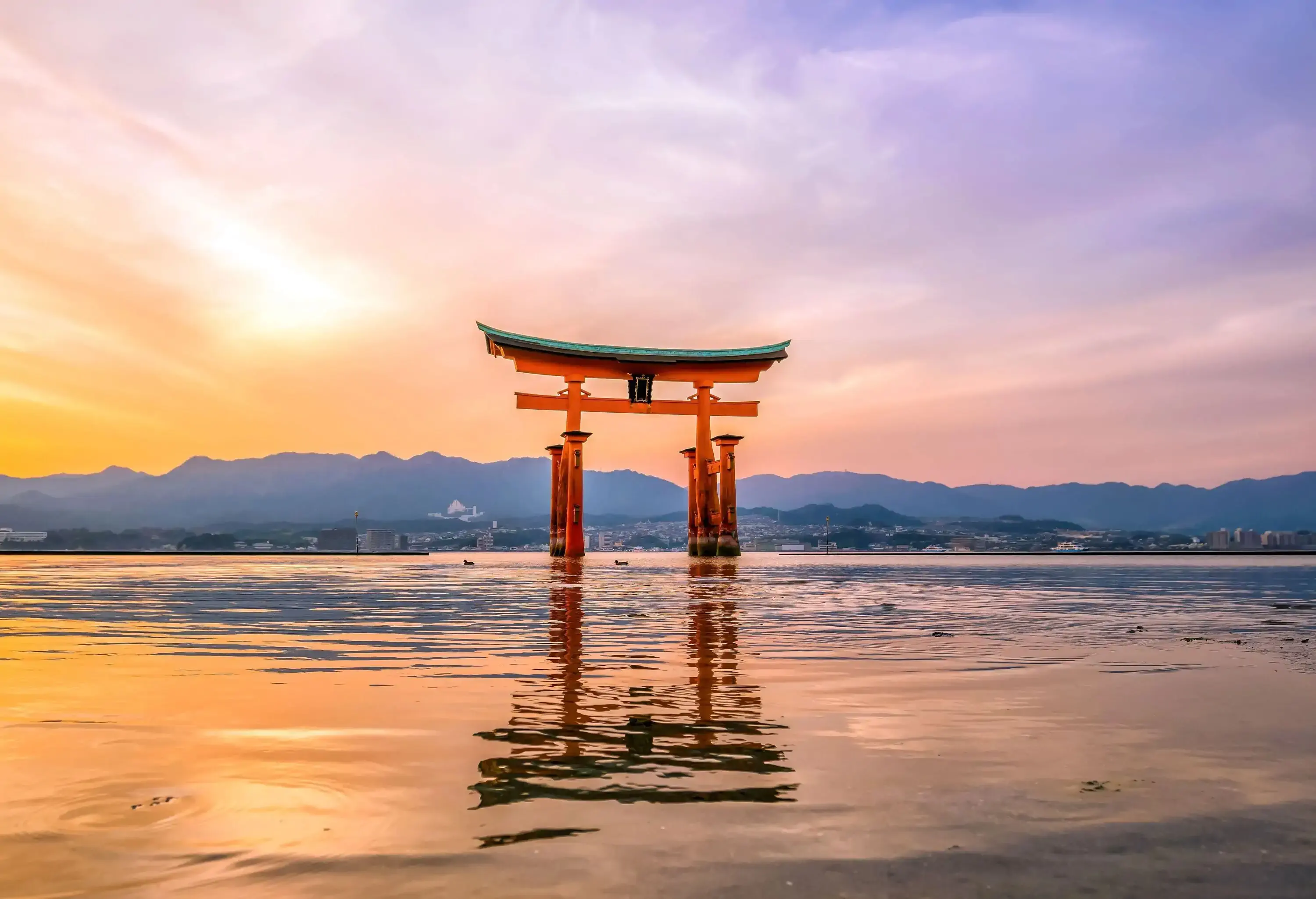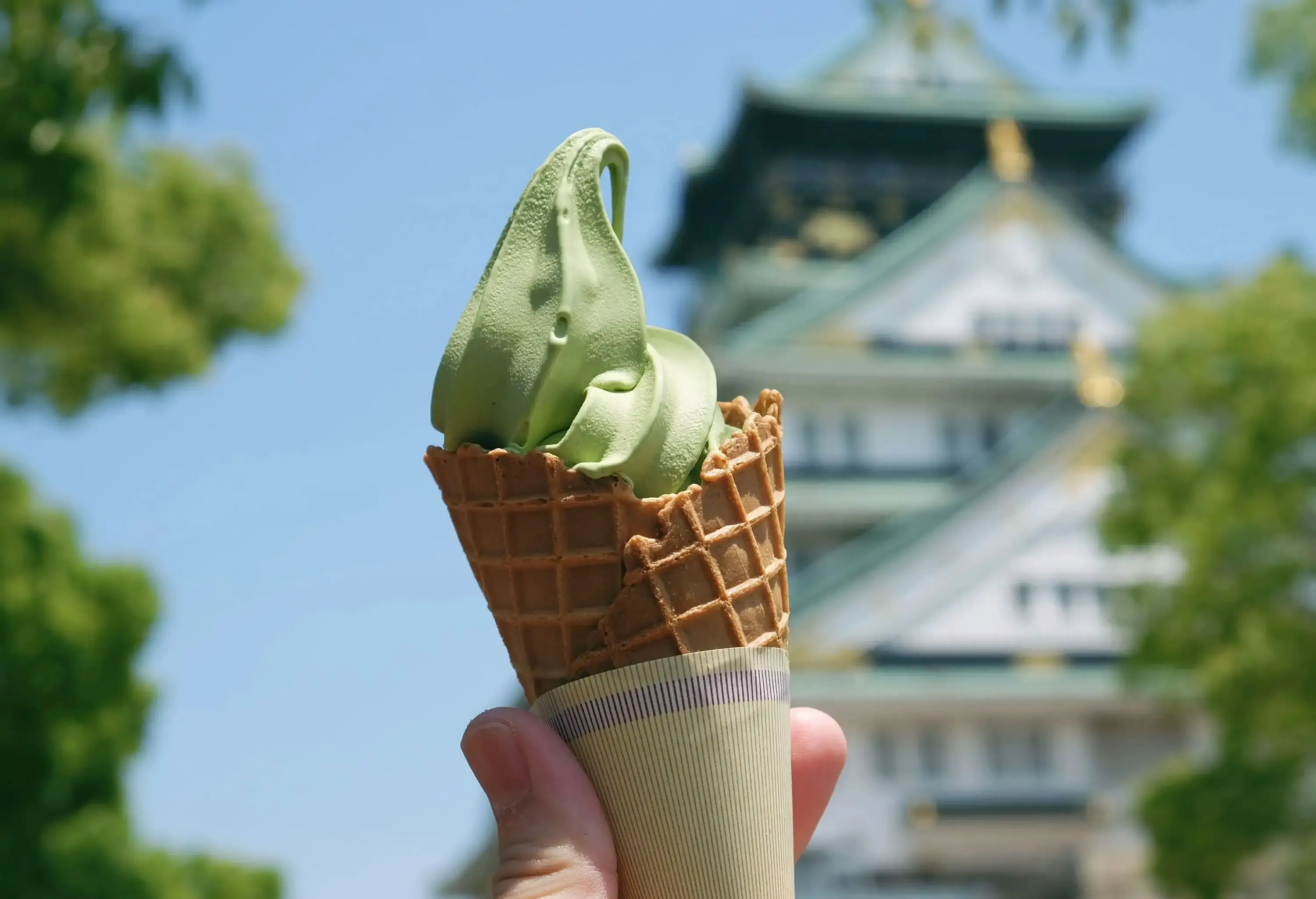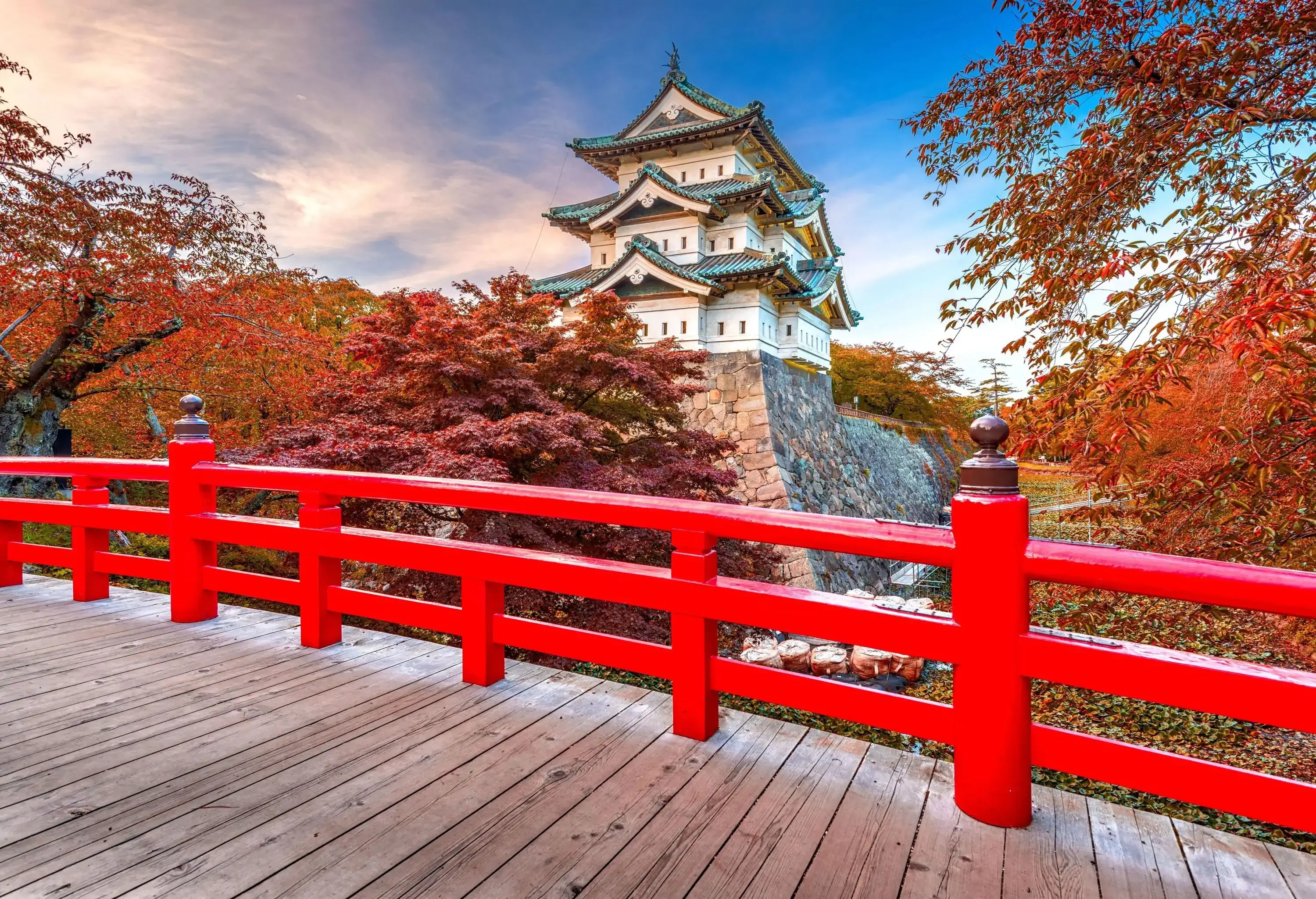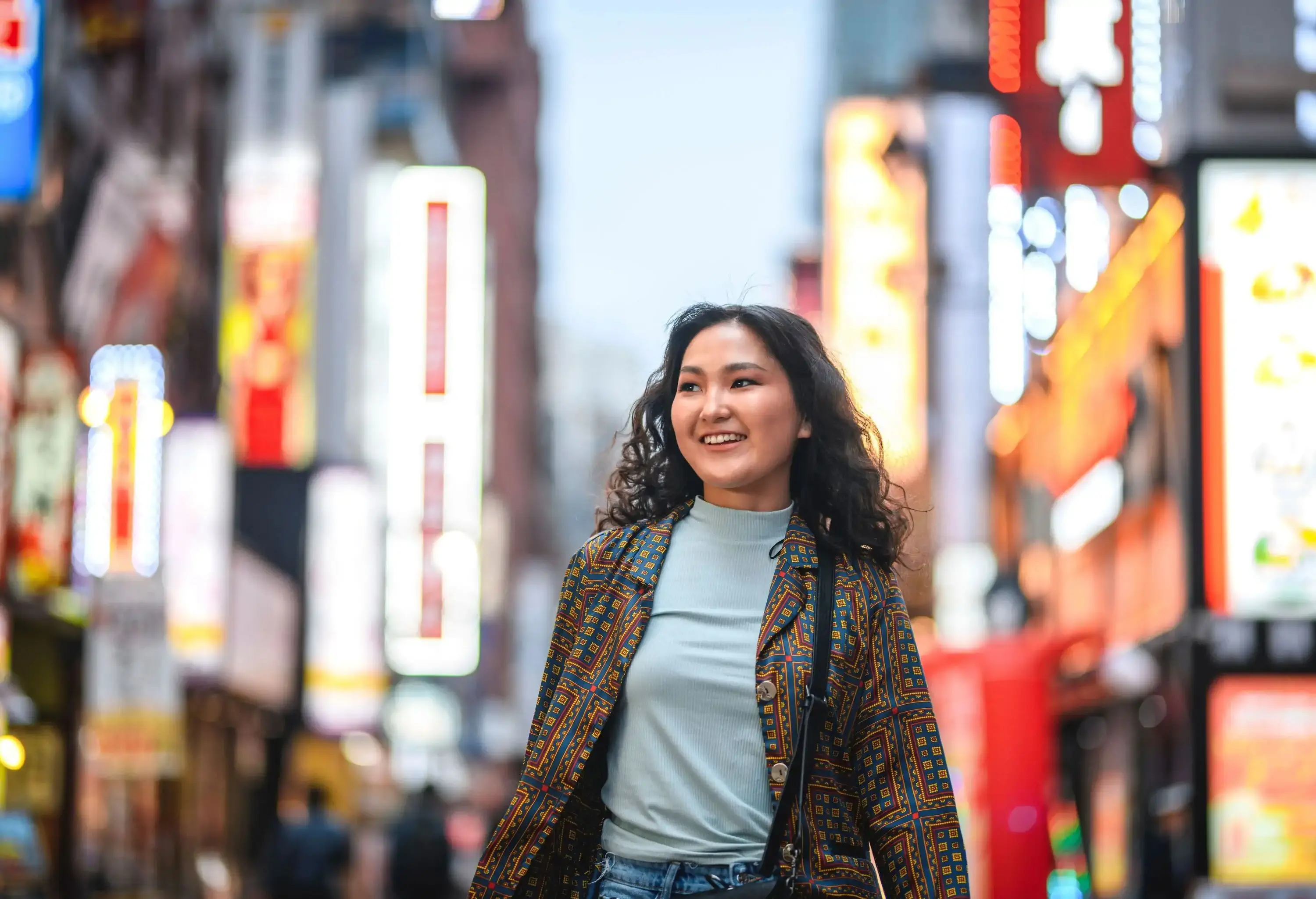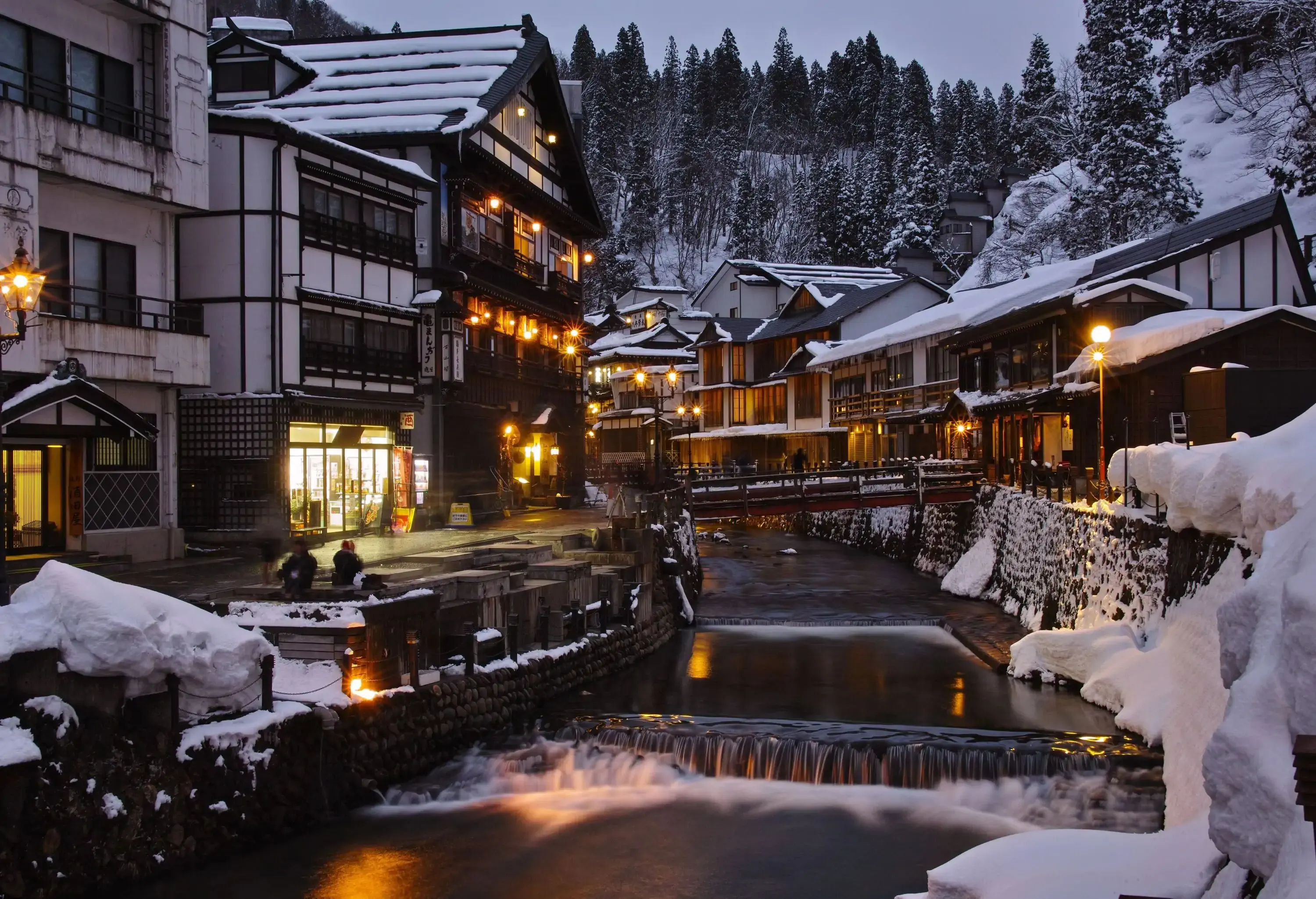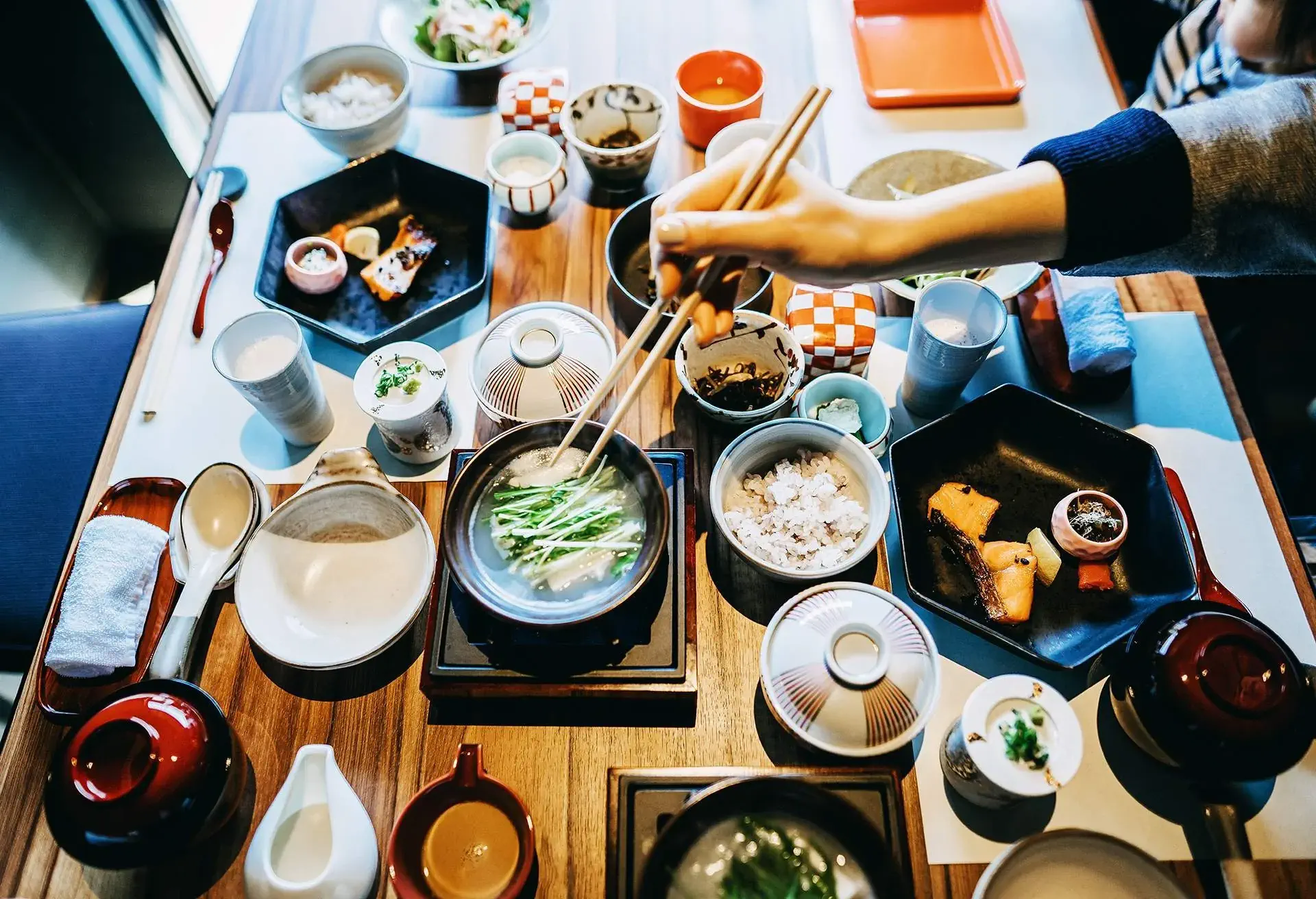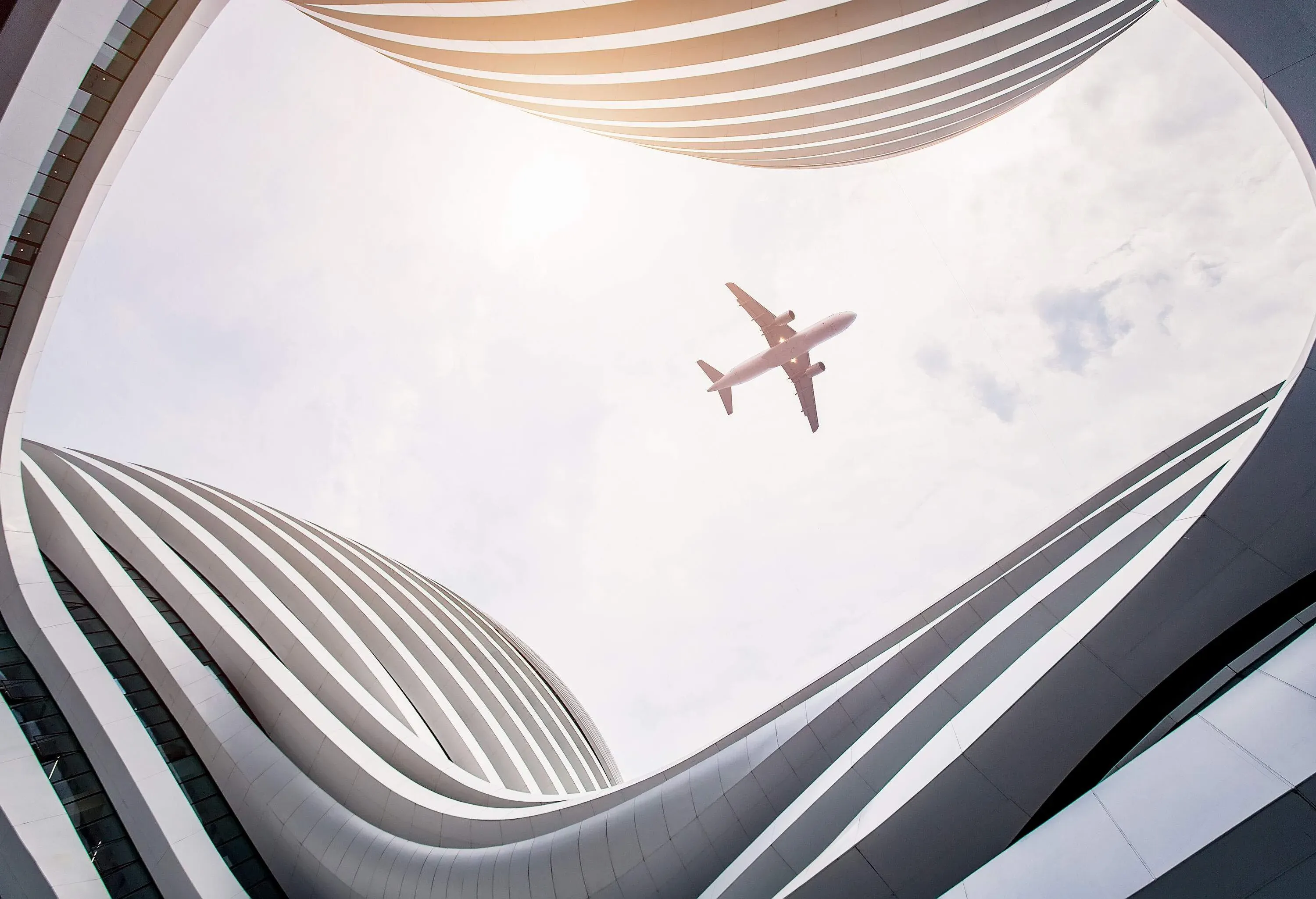The Land of the Rising Sun is a year-round destination. Spectacular from north to south, its wildly varying weather and topography means it’s always lovely somewhere. As with any popular tourist destination, outside factors can impact the experience you have – seasonal crowds and prices, weather and festivals. Here are the best times to visit Japan month by month.
What is the weather like in Japan?
Japan has four distinct seasons. Conditions vary greatly from season to season and across the country. Winter in the north sees temperatures plunge as low as 20°F. Summer in the south sees thermometers climb into the mid 80s, but with humidity it can feel much hotter. While it also sees plenty of year-round rain, it doesn’t compare to the monsoon rain that inundates many Asian countries. You should pay attention to typhoon season though, which runs May to October and peaks in August and September. If in doubt, check with official travel advisories before you book.
High seasons – Mid-March to mid-May and September to mid-November
The splendor of the spring cherry blossom and red leaves of fall are renowned around the world. This is Japan at its most spectacular, so expect serious crowds and high prices.
Shoulder seasons – Mid-May to August and mid-November to December
Japan’s summer months are hot and humid across the country. Although, with averages mostly hovering below 80°F, it’s seldom too hot to enjoy it. From May until July, you can also expect plenty of rain – anything up to 250mm a month depending on where you are.
Low season – January to mid-March
Winter in Japan may be low season, but if you love winter sports, northern Honshu and Hokkaido are meccas for skiing and snowboarding. It’s also the time for some of Japan’s most atmospheric festivals.
So when is the best time to visit Japan?
The warm and dry spring and fall seasons are the best times to visit Japan for its lovely weather and spectacular natural attractions. Peak seasons bring more tourists and high prices – but happily there are plenty of reasons to visit any time of year.
The best time of year to visit Japan month by month.
Looking not only at the best attractions and festivals but also flight and hotel prices to help plan your itinerary, these are the best places to visit in Japan month by month.
Where to go in Japan in January
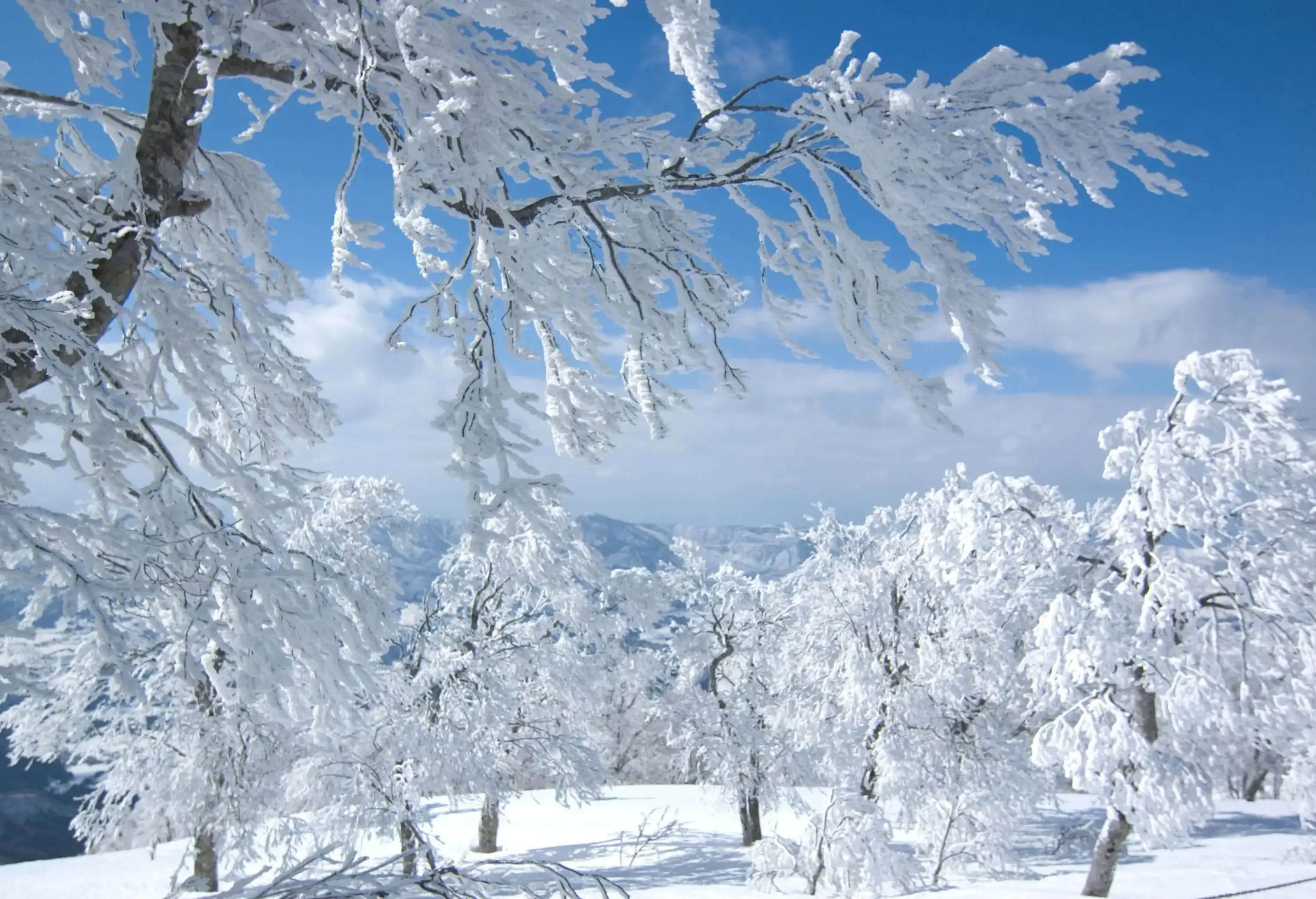
- Average hotel prices: Nagano $68; Matsumoto $77
- Average temperature: 30°F
- Average rainfall: 36-56mm (but lots and lots of snow)
January is snow season, and Honshu Island’s major ski regions like Nagano and Matsumoto are at their busiest and best. Daily snowfall creates incredible and stable conditions, and resorts buzz with international visitors.
In Nagano, take a day away from the slopes to visit Joshinetsu Kogen National Park where wild Macaque monkeys thaw themselves in the Jigokudani hot springs. Stay in a traditional ryokan complete with your own onsen (hot spring) for the full ‘Japanuary’ winter experience.
After the first week of January, flight prices drop significantly. KAYAK data also shows both Nagano and Matsumoto hotel prices are at their lowest all year.
Where to go in Japan in February
- Average hotel prices: Sapporo $175; Okinawa $90
- Average temperature: 23°F in Sapporo and 68°F in Okinawa
- Average rainfall: 60mm in Sapporo(but lots of snow in the north) and 107mm in Okinawa
Japan’s northernmost island, Hokkaido, is the epicenter of winter fun in February. Huge snowfall, freezing temperatures and arguably the best powder for backcountry skiing in the world.
Sapporo is the island’s major city and it has plenty of wonderful winter resorts nearby – Niseko, Rusutsu and Kiroro among the best. Early in the month, the Sapporo Snow Festival brings towering ice and snow sculptures and huge crowds to Odori Park.
For something warmer, head to the far south islands where whale watching season is in full swing. Tours focus around the Kerama Islands but also operate from north Okinawa.
Where to go in Japan in March

- Average hotel prices: Sapporo $87; Tokyo $164
- Average temperature: 30°F in Sapporo and 48°F in Tokyo
- Average rainfall: 80-100mm
March sees Japan in flux as it transitions from low to high season. Early in the month, snow still lingers in the far north of Hokkaido as prices plummet and crowds thin.
To the south, spring blooms start to transform the landscape – first the plum blossom and then later in the month, the cherry blossom.
It's the best time to visit Tokyo. I love the plum blossoms at Yushima Tenjin Shrine – particularly magical in the clear, bright, fresh spring air. Temperatures averaging 48°F keep the serious crowds at bay until later in the month, so it's a lovely time to take advantage.
Where to go in Japan in April
- Average hotel prices: Tokyo $164; Osaka $123 ; Kyoto $181
- Average temperature: 54-59°F
- Average rainfall: 120-149mm
From around March 20 into April is the best time to visit Japan for cherry blossoms, known as sakura. It’s when the Japanese celebrate hanami – flower viewing – with festivals across the country. Days are warming, rain is light and floral aromas fill the air.
In particular, the major metropolises of Tokyo and Osaka are transformed by the sheer abundance of the bloom. Although, with ancient streets draped with soft pink blossoms, nowhere is it prettier than Kyoto.
This is when peak season really takes off, so expect crowds and prices to bloom as well. Don’t let that put you off – this natural phenomenon is one of Japan's great travel experiences.
Where to go in Japan in May
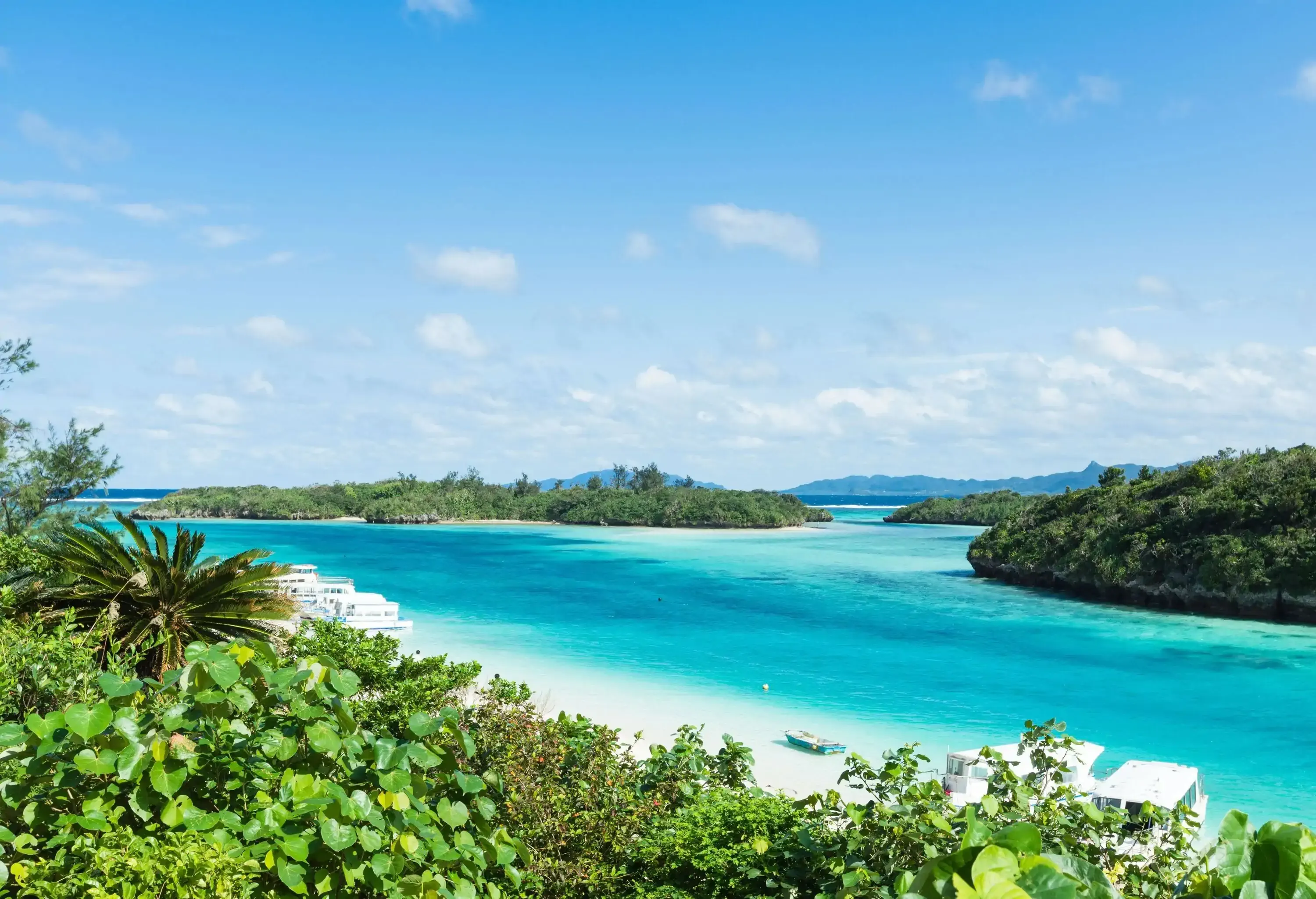
- Average hotel prices: Ishigaki $117; Okinawa $69
- Average temperature: 81°F
- Average rainfall: 182mm in Fuji and 232mm in Okinawa
The first week of May is Golden Week. A coming together of four national holidays – Shōwa Day, Constitution Day, Greenery Day and Children's Day – it’s the busiest week for domestic travel as locals take advantage of the warm, bright weather.
Traditional festivals and celebrations pop nationwide and many museums, parks and attractions are free. Hectic and frantic, my advice is to avoid travel in major tourist zones and cities.
Escape the crowds on the lower slopes of Mt. Fuji. Early May days are bright and dry and its surround valleys are lovely. To the far south, the islands of Ishigaki and Okinawa enter their rainy season later in the month but until then are tropical, warm and usually uncrowded – perfect for exploring gorgeous beaches.
Where to go in Japan in June
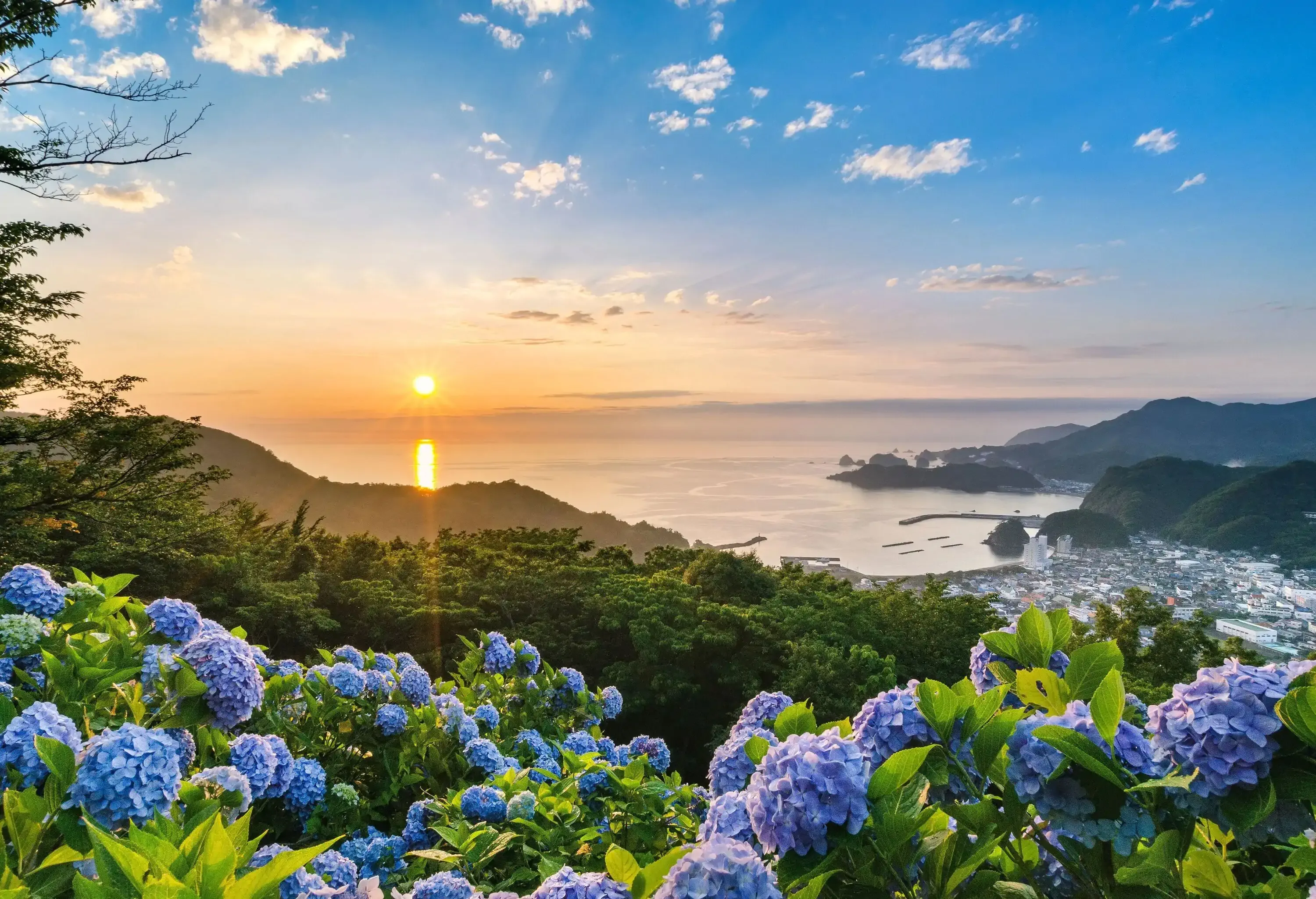
- Average hotel prices: Hakone $336
- Average temperature: 73°F
- Average rainfall: 240mm
Much of Japan is hot and wet in June, known as minazuki, ‘the month of water’. Many domestic tourists leave on vacation making it one of the quietest times to travel and a great chance to sightsee minus the masses.
Much of Japan is hot and wet in June, known as minazuki, ‘the month of water’. Many domestic tourists leave on vacation making it one of the quietest times to travel and a great chance to sightsee minus the masses.
Where to go in Japan in July
- Average hotel prices: Kyoto $124
- Average temperature: 79°F
- Average rainfall: 203mm
Near peak summer temperatures and plenty of rain make the cities a double edged sword in the height of summer. They swelter on the streets but offer plenty of dry and air-conditioned respite in museums, temples, malls and the like.
Kyoto is my pick for the Gion Matsuri, one of Japan's most famous and biggest festivals running for much of the month. The major parades happen on July 17 and 24 – expect giant floats, buzzing Yoiyama night parties, incredible street food and a carnival atmosphere.
Where to go in Japan in August
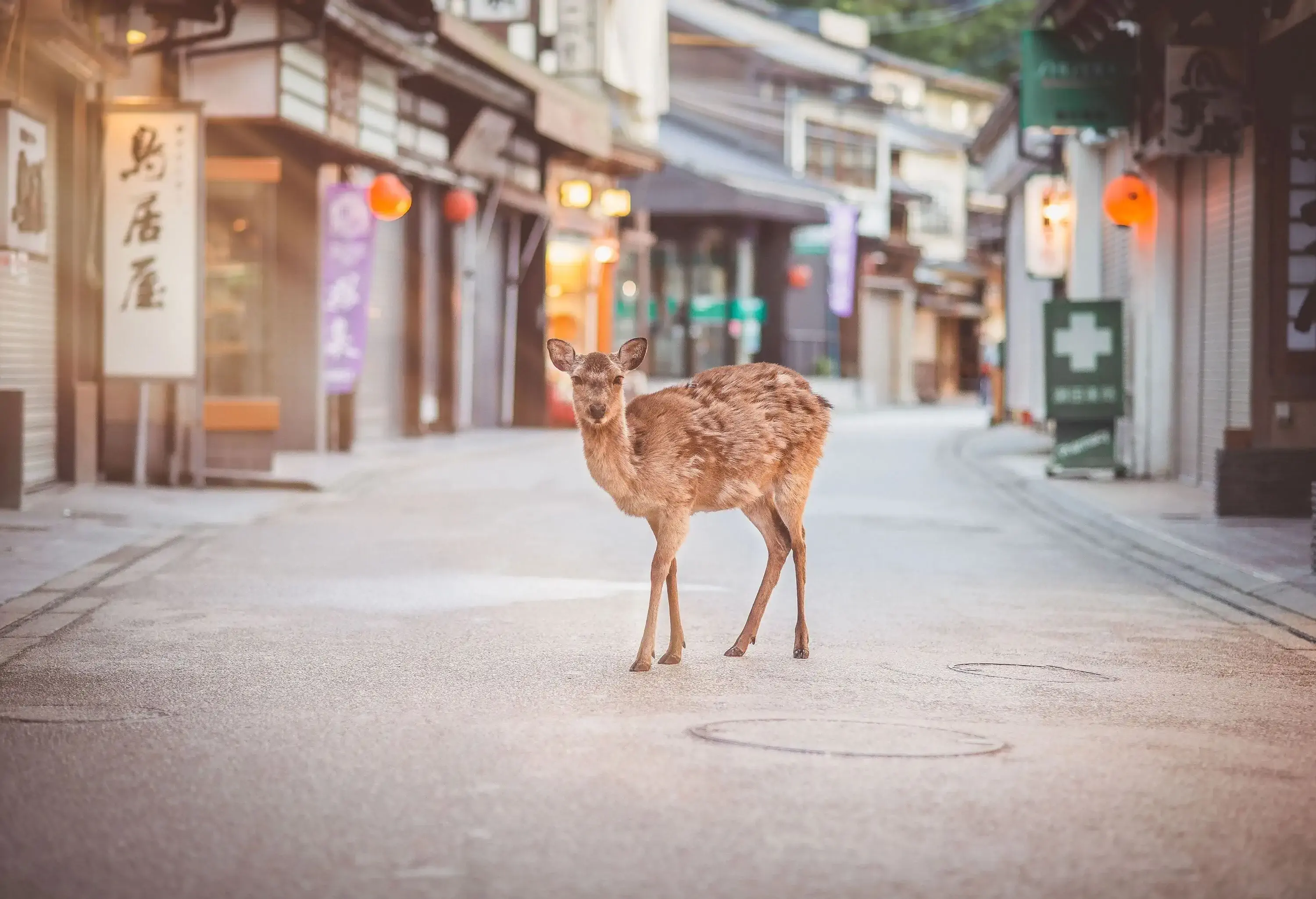
- Average hotel prices: Nara $85
- Average temperature: 74°F in Fuji (but much colder on the summit) and 91°F in Nara
- Average rainfall: 182mm in Fuji and 195mm in Nara
Hot and muggy with the threat of typhoons, August is the least appealing month to travel in Japan’s central regions. Osaka, Kyoto and Hiroshima see temperatures in the mid 80s coupled with drenching humidity.
Instead, strap on sturdy boots and climb Mt. Fuji. Summit trails will be open but busy – particularly during the Obon festival, mid-month. Book well in advance, prepare for vastly different conditions and check local info on the day of your climb.
Although it’s more popular in spring, I also love Nara at this time of year. The Nara Tokae Lantern Festival lends long warm evenings a lovely glow – magic for feeding the friendly deer their shika senbei (deer crackers)!
Where to go in Japan in September
- Average hotel prices: Hiroshima $103; Sapporo $130
- Average temperature: 61°F in Sapporo and 75°F in Hiroshima
- Average rainfall: 150mm in Sapporo and 190mm in Hiroshima
The height of typhoon season means central and southern regions are at their wettest in September. Showers are often short and sharp though, and many typhoons don’t even make landfall. That means you’ll get plenty of warm, bluebird days too – hence it’s the start of high season.
Of the major metropolises, I love Hiroshima at this time of year. The floating tori gate Itsukushima on nearby Miyajima Island looks otherworldly come rain or shine. And the city’s signature Okonomiyaki always hits the spot.
Late in the month, fall comes to the far north of Hokkaido. Temperatures drop and the foliage slowly turns the landscape shades of red and gold.
Where to go in Japan in October
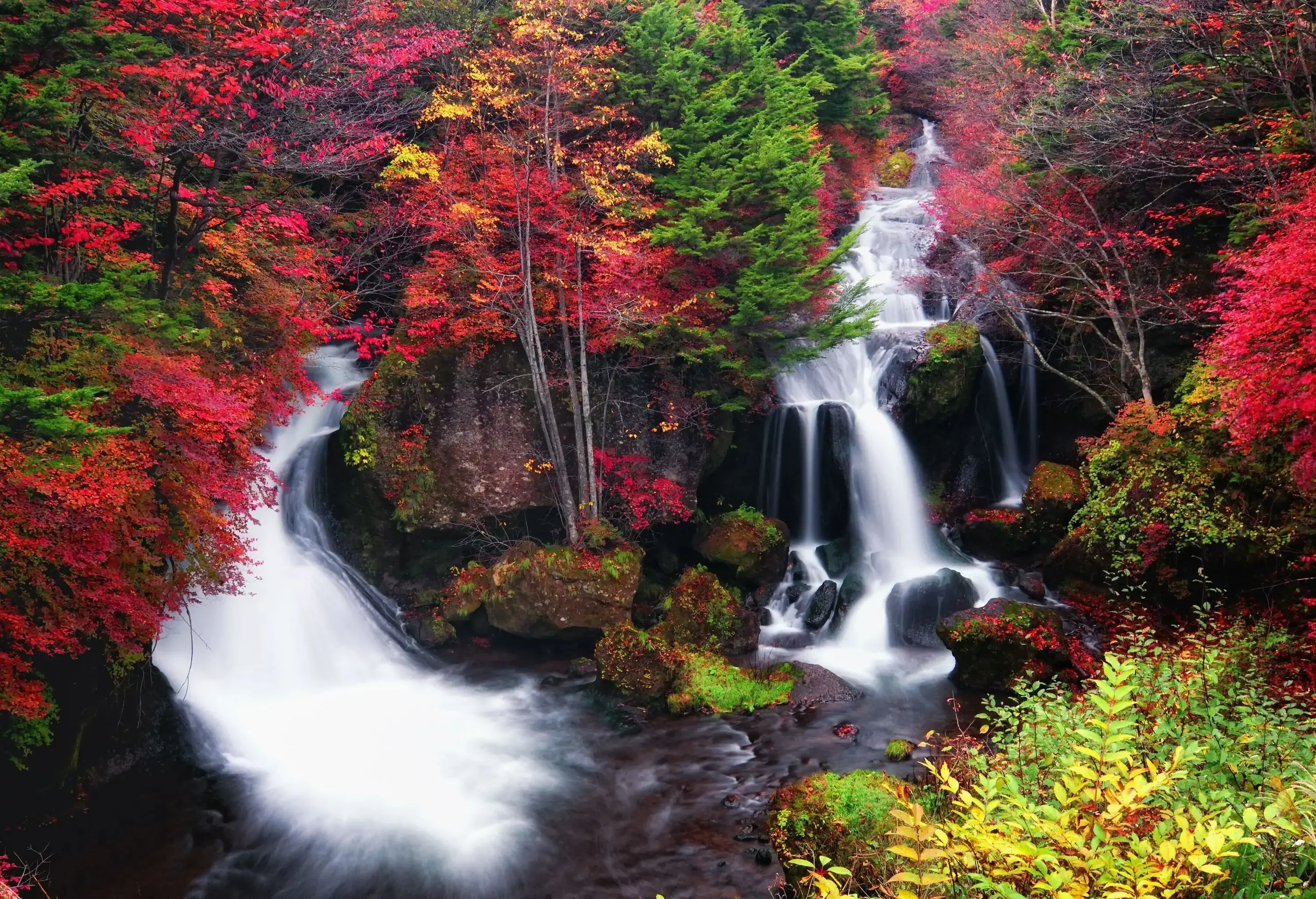
- Average hotel prices: Tokyo $161; Nikko $168
- Average temperature: 66°F
- Average rainfall: 190mm in Tokyo and 159mm in Nikko
October sees those spectacular fall colors spread south through the mainland as harvest season arrives. North to south, temperatures are mild and the rains ebb away.
A couple of hours north of Tokyo, Nikko is at the height of its fall splendor in the second half of the month. Lake Chuzenji, Kegon Waterfall and the Irohazaka Winding Road are at their most dramatic.
With crowds and higher prices, I found an overnight trip from Tokyo the best way to enjoy it. Time a visit with the Nikko Toshogu Shrine Annual Grand Autumn Festival to see Samurai processions and traditional horseback archery displays.
Where to go in Japan in November

- Average hotel prices: Fukuoka $132; Nagasaki $142; Kobe $119
- Average temperature: 54°F in Kobe, 57°F in Fukuoka and 64°F in Nagasaki
- Average rainfall: 74mm in Kobe, 43mm in Fukuoka and 86mm in Nagasaki
November is the best time to visit Japan in the fall. The maple leaves shimmer momiji red across the country, the weather is mild and dry, and many places are quieter as high season tails off.
On Kyushu Island, the cities of Nagasaki and Fukuoka are just about perfect for weather and leaf peeping. While you’re there, drop into the Fukuoka Grand Sumo Tournament where young wrestlers showcase their skills in the hope of making the big time.
Landmarks in Kyoto, Kobe and Kawasaki in particular never look more spectacular, which explains the crowds. KAYAK data shows November is the busiest month for all three.
Where to go in Japan in December
- Average hotel prices: Sapporo $116; Hakone $305; Nagano $114; Tokyo $162
- Average temperature: 28°F in Sapporo, 50°F in Hakone, 36°F in Nagano and 48°F in Tokyo
- Average rainfall: 50-70mm (snow in the north)
The start of winter sees the snow return to Japan’s far north as ski season winds back into gear. The rest of the country is cold, clear and for the first half of the month, light on crowds and low in cost.
Although Christmas isn’t a traditional Japanese holiday, cities still go wild in celebration. Unsurprisingly, Tokyo goes biggest – huge light displays, a carnival atmosphere and lots and lots of Kentucky Fried Chicken!
Based on flight searches made on KAYAK & associated brands in the period between 09.08.2023 and 09.08.2025 for flights with departure between 01.01.2024 and 31.12.2025 from any US airport. All prices are average prices for economy, return tickets. Prices may vary and savings cannot be guaranteed. Percentages for changes in searches are approximate.
Based on hotel searches made on KAYAK & associated brands in the period between 09.08.2023 and 09.08.2025 for travel days between 01.01.2024 and 31.12.2025. All prices are average for 1 night in a double room. Prices may vary and savings cannot be guaranteed.
Weather data is pulled from a third party site, Weatherbase, and has not been verified by KAYAK. Monthly average temperature and precipitation data is based on historical insights from the past 102 years. Weatherbase data is updated from the US Census Bureau and other databases worldwide. Weather data for Fuji, Hakone, Nara, Nikko, Nagasaki and Okinawa was pulled from the Japan Meteorological Agency.

